Due to damage from the winter storms in 2023, the pier is currently closed. It is unknown when or if it will reopen.
Public Pier — No Fishing License Required
Only a few piers have truly unique features and this pier is/was one of them. The end of this wooden 500-foot-long pier connects to the old cement ship Palo Alto, a bad idea turned good that has now turned bad once again. The ship was designed for the U.S. Navy in World War I but was not completed until the war was over. She sat at her dock in Oakland until 1929 when she made her only voyage—to her present spot. The 435-foot-long ship was filled with water, a pier was built from the beach to the ship, and the ship was turned into a floating attraction (although she didn’t really float). A cafe was constructed above deck, the main deck was turned into a dance floor, a heated swimming pool was added and carnival booths lined the back of the ship. Within several years, the company that owned the ship went bankrupt. Later, winter storms damaged the already paralyzed craft.
Although the ship was a bad idea for the company’s investors, it turned out to be an ongoing attraction for beach go’ers and anglers who flocked to the ship for what could be at times excellent angling. Although the smaller species predominated, reports of good-sized striped bass, halibut, and white sea bass lured anglers as did the occasional salmon and steelhead.
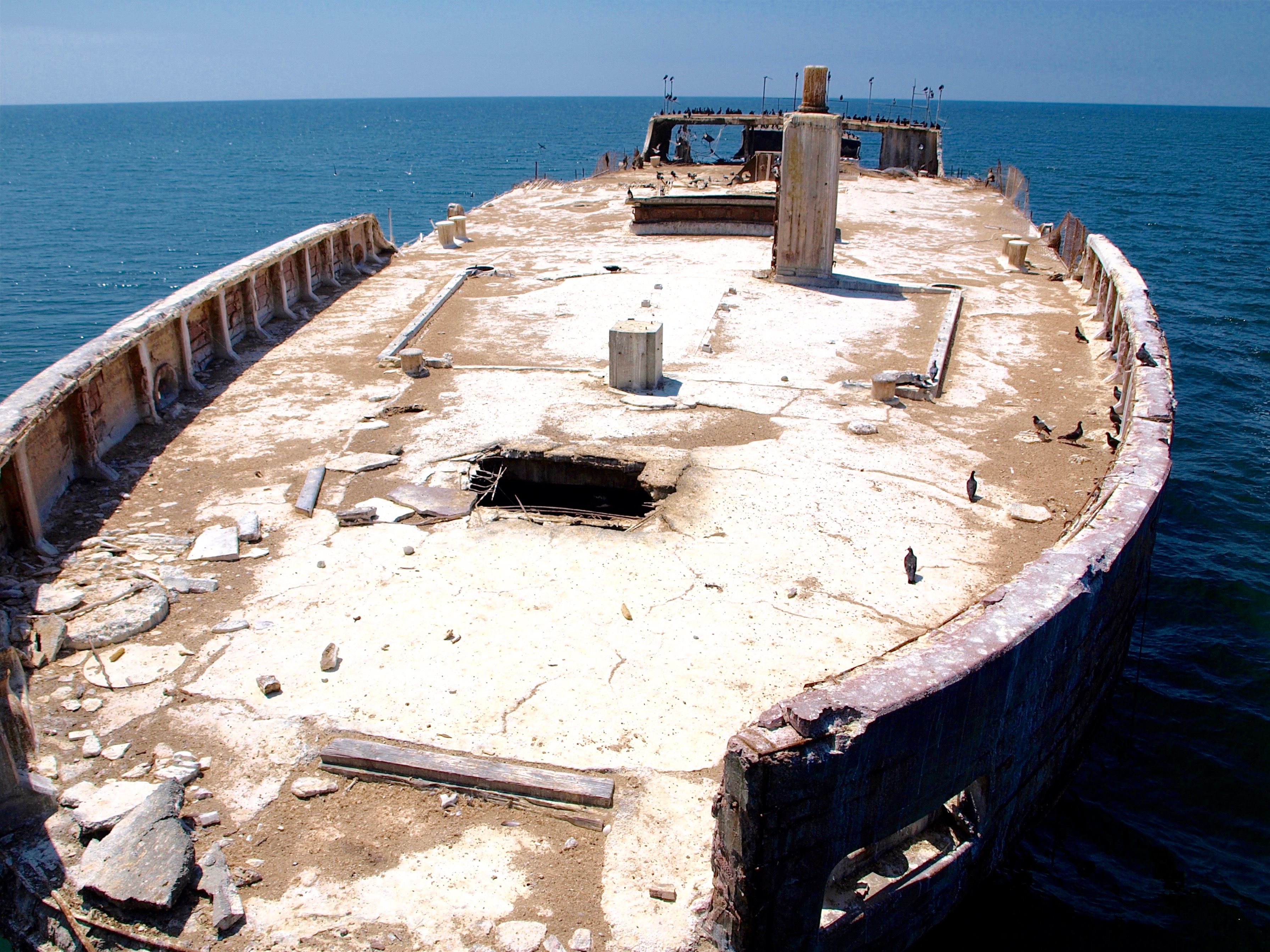
In 2015 the ship was still upright but still resembled a ghost ship.
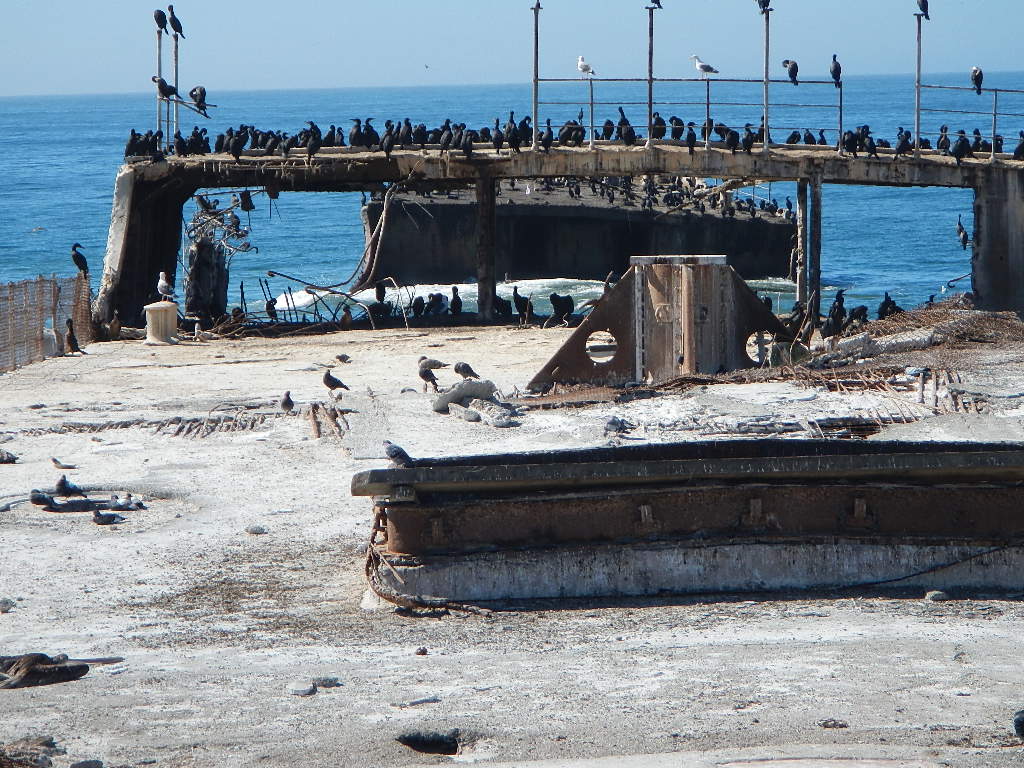
Birds have made the ship home for many years.
That bonanza of fish was mostly true in the early years, especially into the ’50s, but even recently, when water conditions were right (especially El Nino warm-water years), it could produce some excellent catches. Locals with the know-how would almost every year find some of the larger species included in their summertime catches.
Unfortunately winter storms in 2017 finally resulted in the hull of the ship turning on its side, an event which also affected the pier itself. About half of the outer portion of the pier was lost to angling and it’s a question mark if the state (even with a so-called bloated surplus of funds) has the willingness to make proper repairs to the pier.
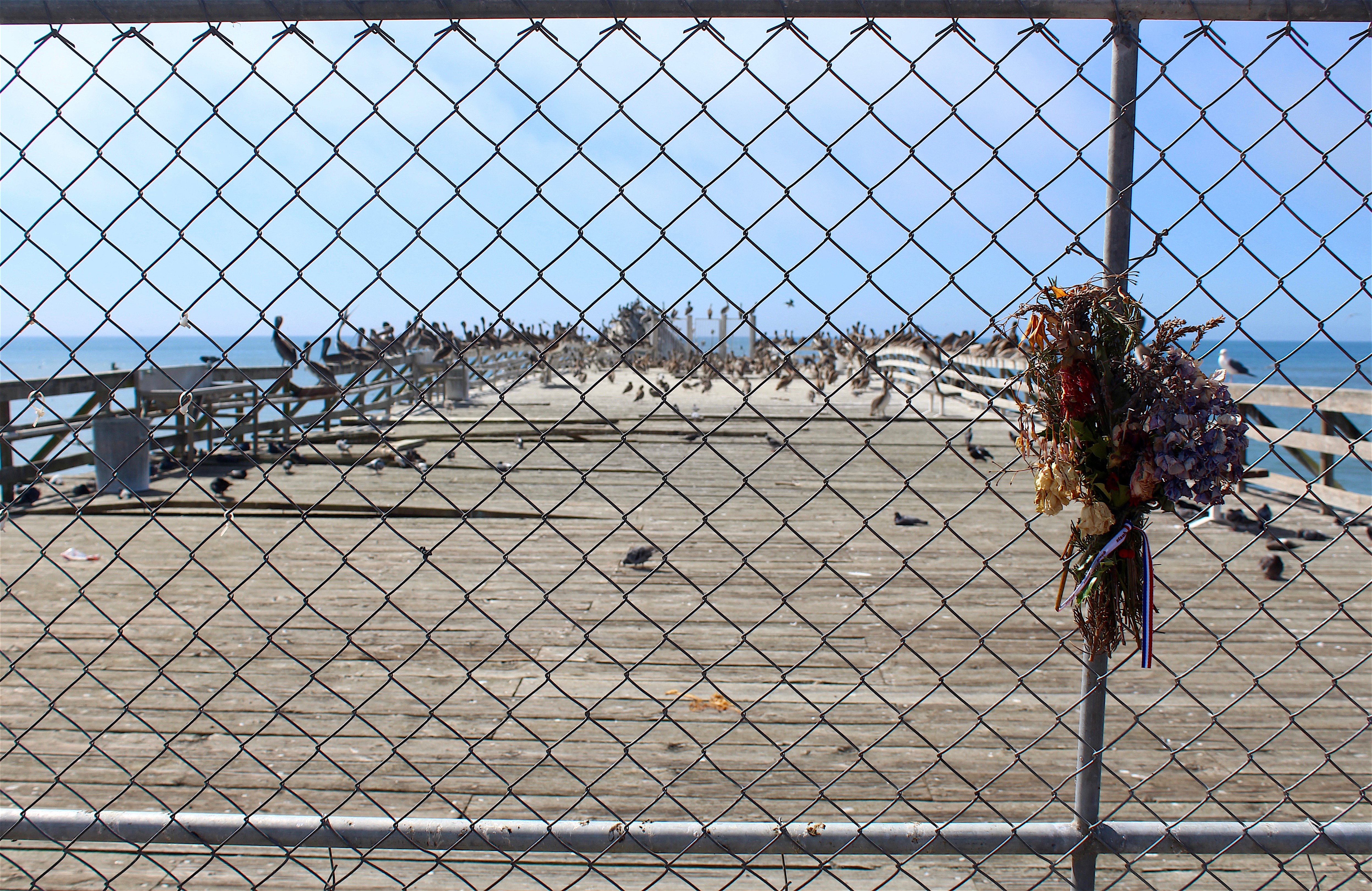
About half of the old pier sits behind fencing, inaccessible to anglers.
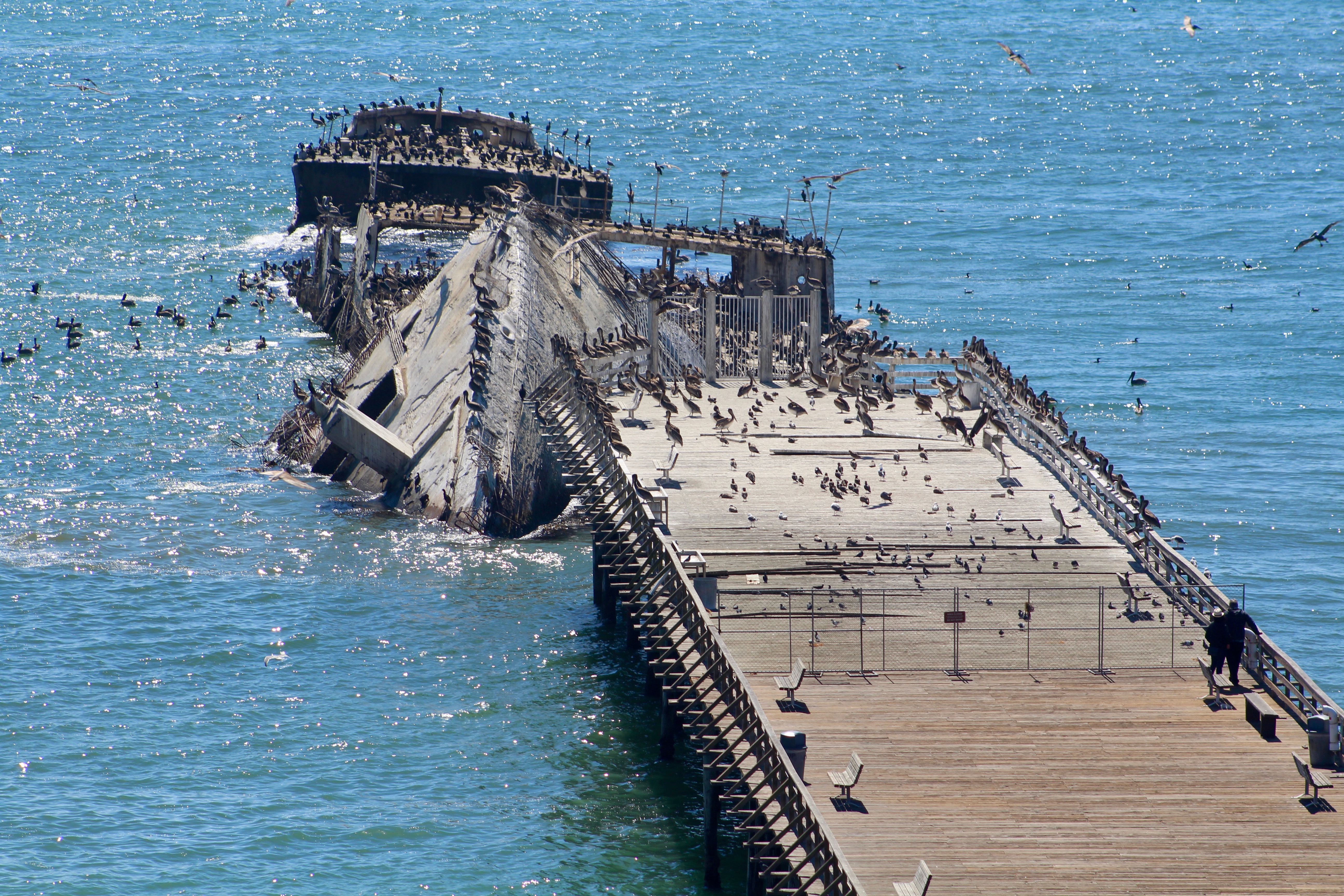
Given the shortened length of the pier today, most angling is for surf species and fewer of the large species can be expected. And, even if the larger species do make a showing, crowding and conflict may be inevitable.
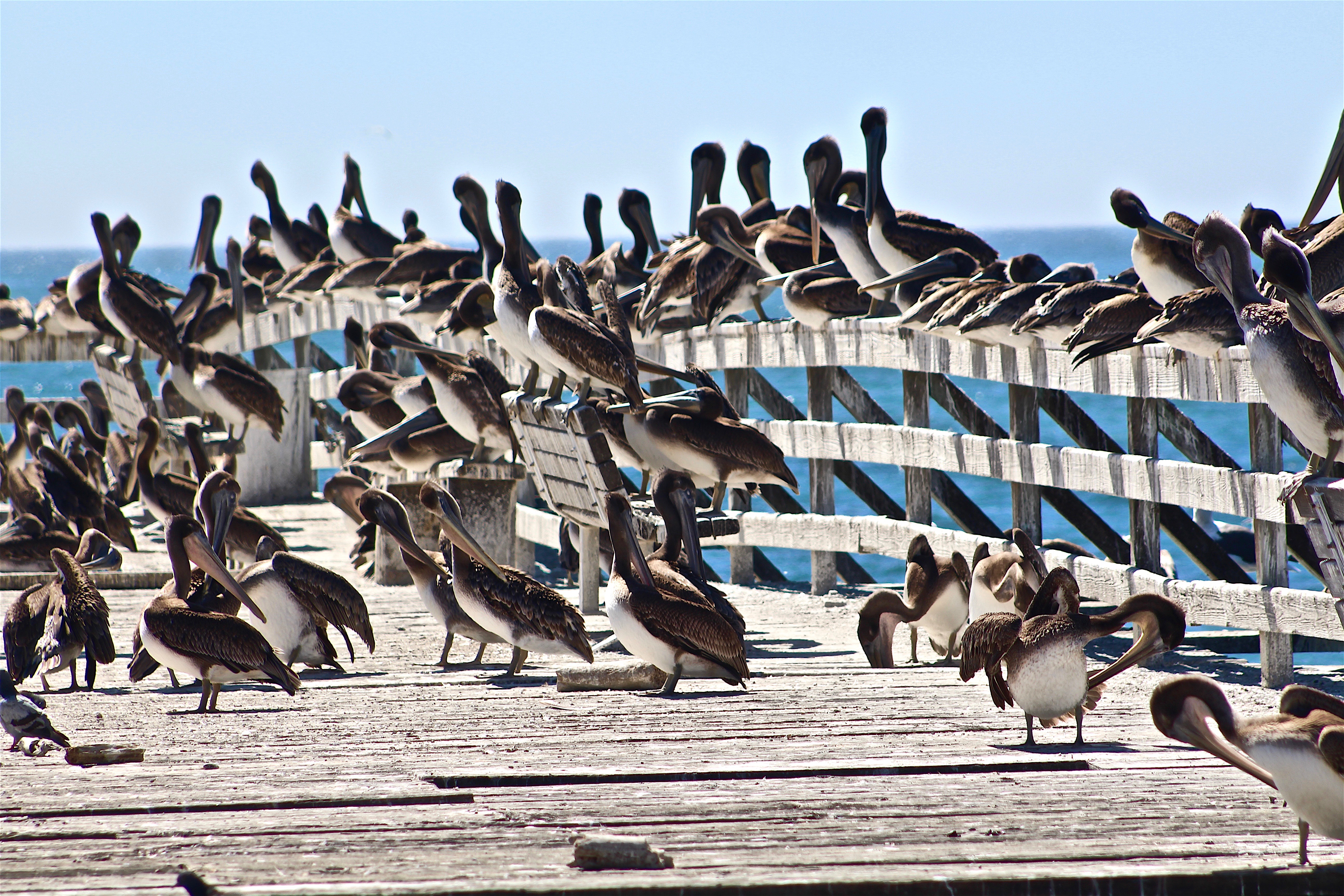
As is, it is a pier that I no longer recommend. My last visit in September of 2018 saw few fish but somewhat unbelievable numbers of bothersome kelp flies. The ship and the pier section now closed to anglers was covered with birds and bird droppings and the stench was overwhelming.
Environment. Seacliff State Beach is a sandy beach that connects with New Brighton Beach to the north and Rio Del Mar Beach to the south; all are noted beaches from which to catch surfperch. A short distance south of the pier sits the outlet of Aptos Creek. The park and pier sit in a pocket of Monterey Bay known as Soquel Cove, an area seasonally filled with baitfish and correspondingly frequently home to larger species—halibut, striped bass, white seabass (some years), and thresher sharks.
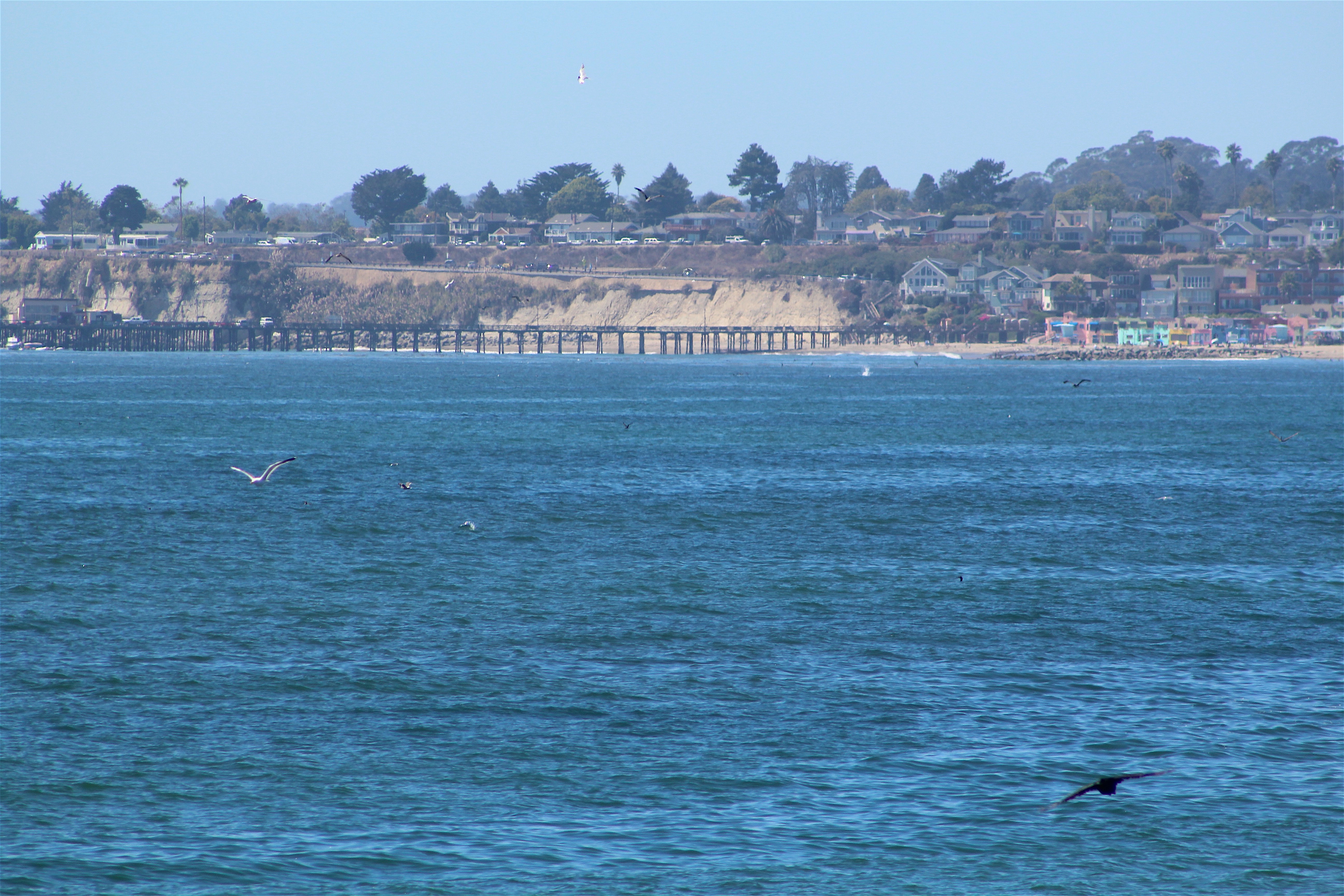
The Capitola Wharf sits a fairly short distance upshore from Seacliff
Given today’s shortened pier, anglers are primarily presented a shallow-water, sandy-shore environment under and around the pier. What was a second environment further out on the pier — deeper water and access near the ship, has now been lost.
In the surf area, the angler can expect to catch the large barred and calico surfperch (with the ratio of barred to calicos being about 3-1) as well as the smaller walleye surfperch, silver surfperch and often all too common (and pesky) shinerperch. Less common but caught most years will be white seaperch, spotfin surfperch, and a few sharpnose seaperch.
Kingfish (white croaker—numerically the number one fish at the pier), jacksmelt, and a buffet of small flatfish round out much of the action — sand sole, starry flounder (a few), English sole (a few), and Pacific sanddab. Although rarely ever seen today in the numbers that once existed, baby bocaccio, round out the catch for the smaller species (but remember that the fish are strictly regulated today).
This same mid-pier to the end area will yield up pelagics when they enter the local waters. Spanish mackerel (jack mackerel) are common most years, the sardines have returned and are also common, while Pacific mackerel visit some years. Most people fish for these with Sabiki-type rigs and use the fish for bait although others will fill a bucket and use them for food.
Most years will also see some king salmon, striped bass and California halibut landed, most commonly in the summer to fall months, and generally by the locals putting in their time on the pier. Increasingly, in the mid-to-late ’90s, white seabass have also entered into the picture (and a 45-pound fish was landed in August of ’00). Warm water years may also bring species more common to the south and both kelp bass and sand bass have been reported from the pier. As said, it’s hard to predict how many will show up in the shallower waters now available to anglers on the pier.
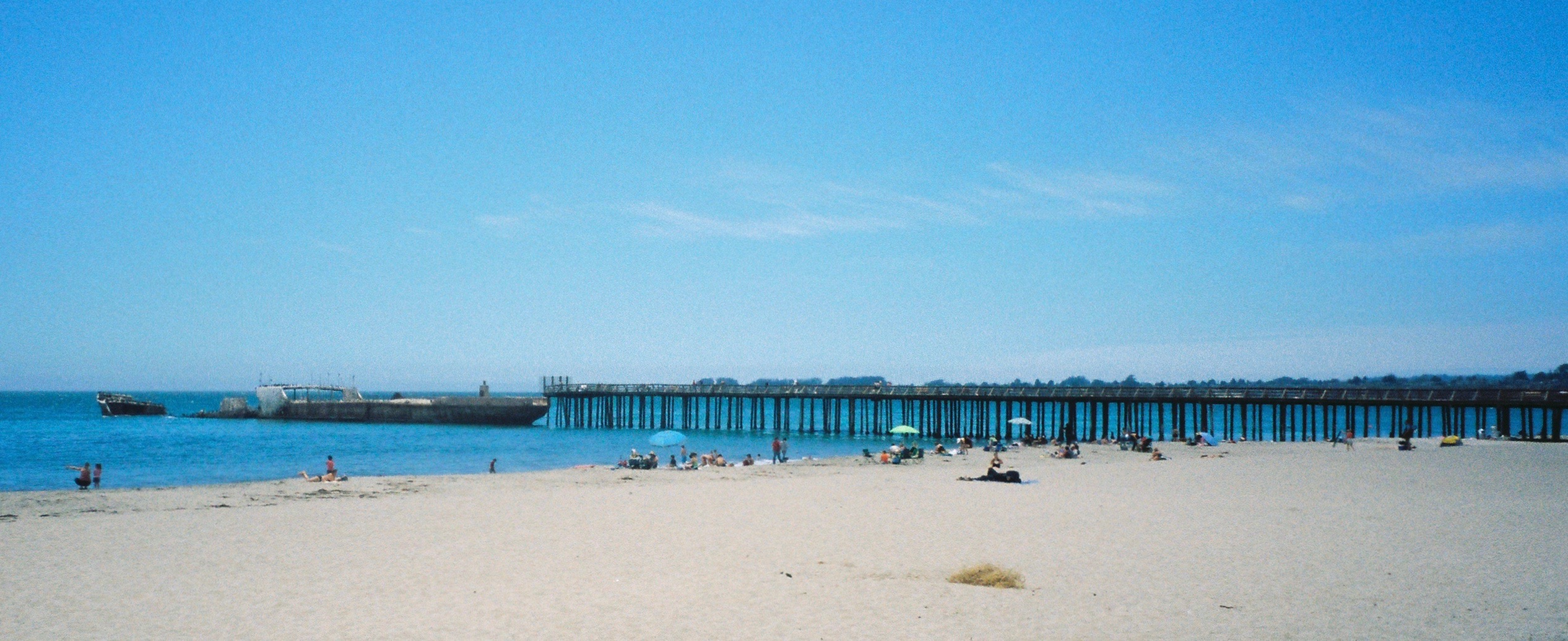
Although a number of species were once available out by the ship, I’m not too sure how many will show up today, species such as pileperch, rubberlip seaperch, blackperch, rainbow seaperch, and a few small cabezon and kelp rockfish. A few steelhead will also generally be landed during the fall and early winter months most years.
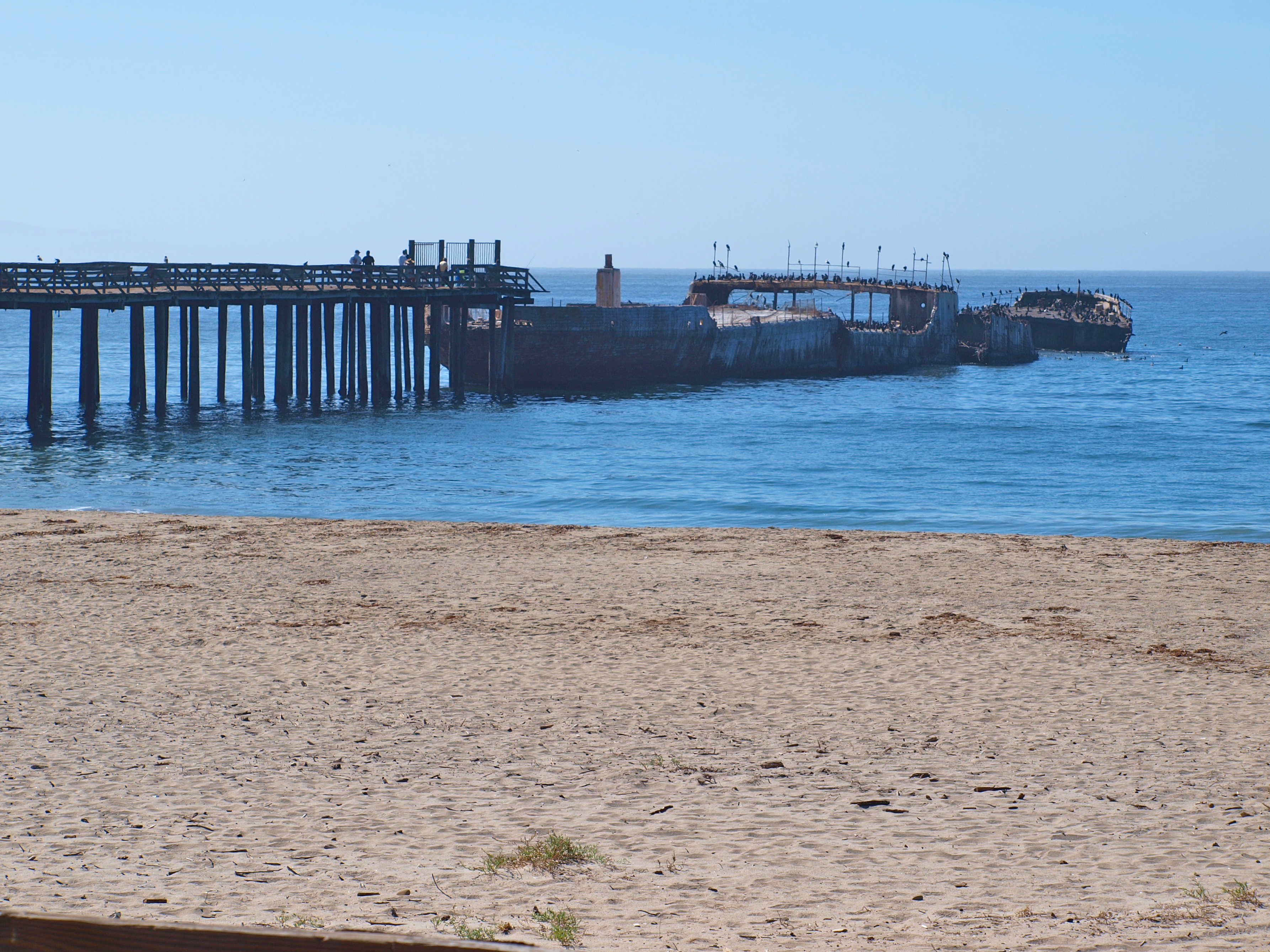
The way it used to look.
This is yet another pier that occasionally sees too many pelicans, although rarely the number seen at Santa Cruz. Nevertheless, the pier was shut down several days in August of ’08 to protect the number of pelicans accidentally being hooked by anglers.
A word of caution! This can be one of those piers where the regulars think they own the pier and to some degree don’t mind making life miserable for the non-regulars. Of course when a regular has a half dozen rods, has been drinking (or doing drugs), and seems to be camped out on the pier, it can almost be expected that there could be problems. I’ve seen it a couple times, both times when the stripers and halibut were biting, and was somewhat surprised no one raised a fist. I was even more surprised that the park rangers didn’t have better control of the problem. Hopefully it’s been corrected.
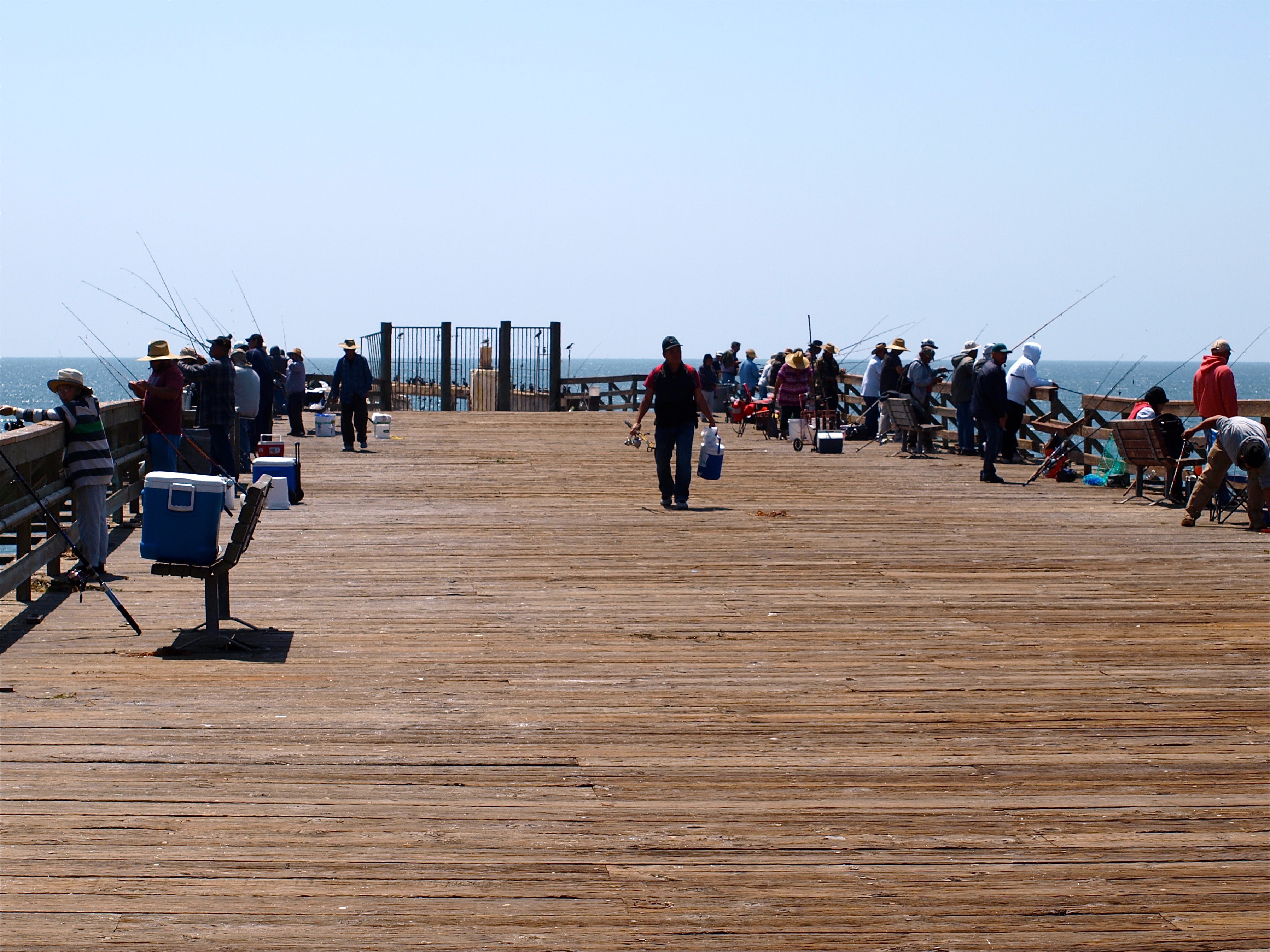
The pier was crowded when the pier was longer and the fish were biting, expect even more congestion today if the “biggies” show up.
Fishing Tips. Whenever possible, fish the surf area with live sand crabs (soft shell are best); if these aren’t available, use pile worms, ghost shrimp or fresh mussels for bait. Winter is the best time for large barred surfperch, winter and spring for the calico surfperch. Motor oil and root beer colored grubs can also be used for these perch and since this pier is built close to the water it’s a good place to try your artificial lures. Add some shrimp scent to the grubs for increased production. However, the surf here is typically only moderate and I haven’t had as much luck with the plastic grubs as at beaches with heavier surf. Do try to hit the pier near high tide if you’re seeking out the perch, two hours before to two hours after are the peak times.
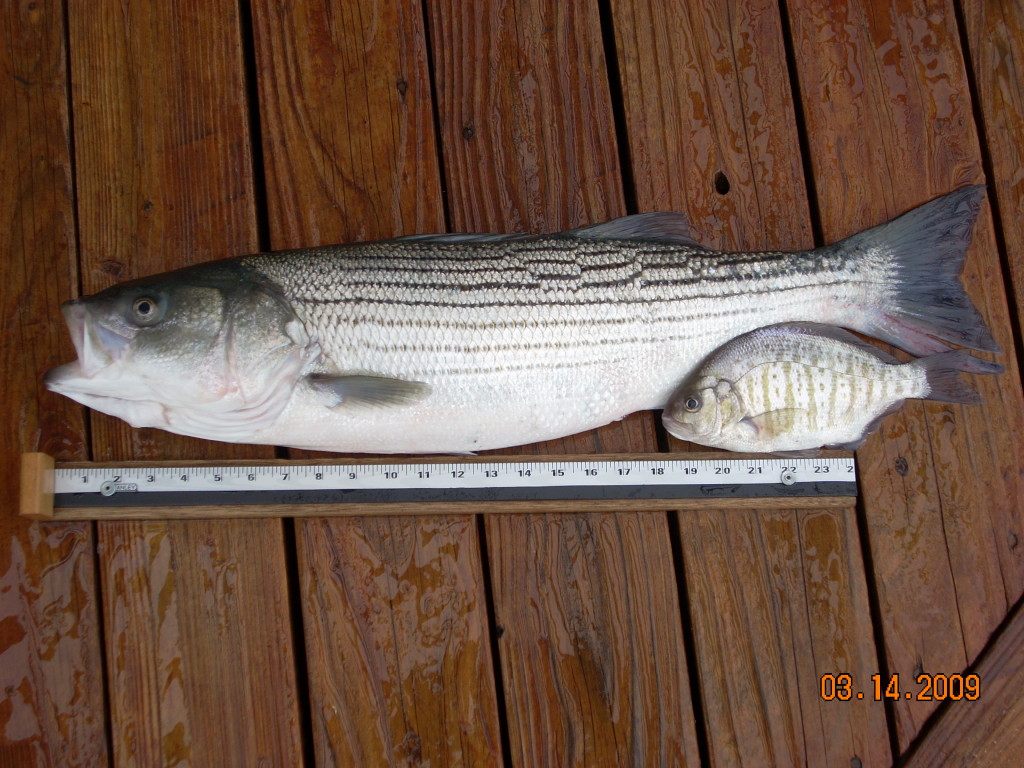
Striped bass and barred surfperch
If you do use an artificial lure, be careful of the nearshore bathers and the crowds on the pier. One day I saw a young girl get hooked in the face by the errant actions of an equally young boy. She was simply walking on the pier, he was paying no attention to anything except his friends. Having trouble casting a lure that was far too light for his tackle, he whirled it about and impaled the young girl with the treble hook of his lure. It was not a pretty sight.
Fish on the bottom using anchovies for sand sole, starry flounder and white croaker. Sole bite best in the spring, the flounder winter to spring, and the kingfish summer to fall (although some winters see large concentrations of these small croakers). Use a small piece of anchovy and fish mid-depth for walleye and silver surfperch. Fish near the top of the water and use pile worms for jacksmelt.
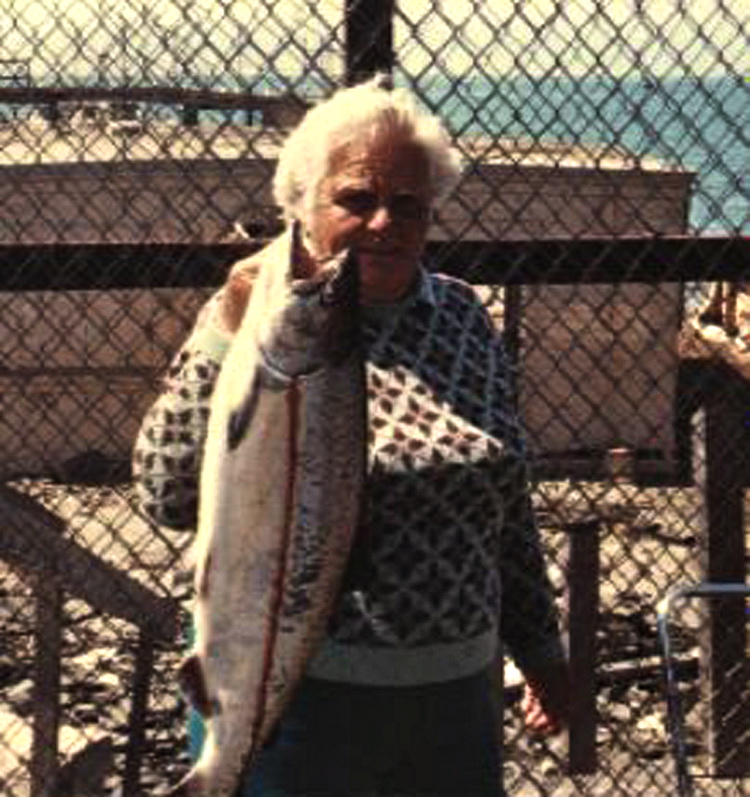
Rose Costa was a regular at the pier — and an excellent angler. Here she has a salmon
From June through August, use a live shiner, smelt, sardine (or small mackerel when available) and fish on the bottom for halibut and stripers; fish with the same bait but near the surface for salmon. As said, numbers will propbaly be down given the shallower water now available.
A plethora of different lures are used for the stripers; a few of the best are Hair Raisers, i.e., Spro bucktails, Pencil Poppers, Lucky Craft Pointers and white swim baits. Halibut like soft plastics with Big Hammer, among others, being a favorite. Again, the pier can be very crowded so take care to insure that you do not tangle lines or endanger anyone.
Some years will also yield a few steelhead during the late fall months; most of these will be landed on worms or small lures.
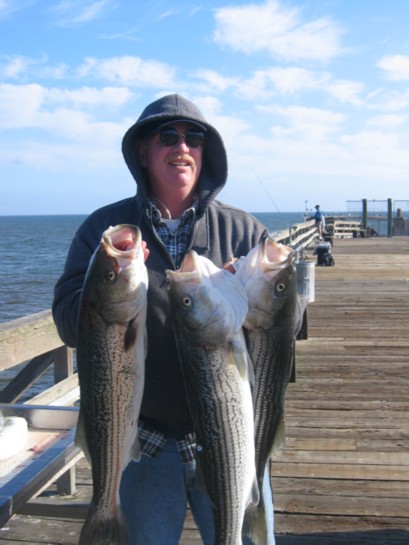
A trio of stripers
If seeking out perch, the typical bait is pile worms, fresh mussels or small pieces of shrimp along with small hooks, size 6 or 8.
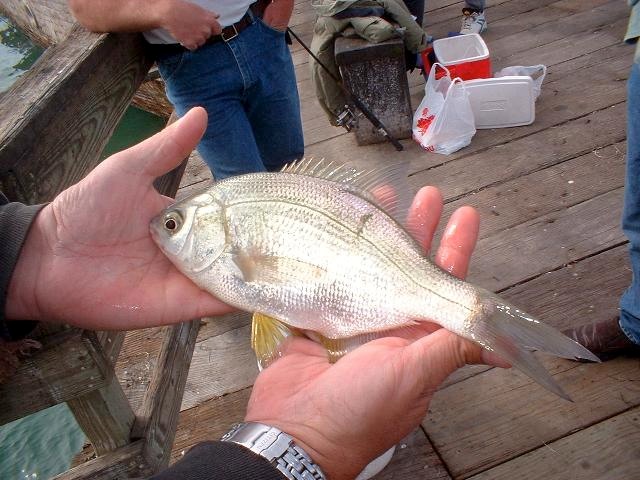
A white seaperch
A favored species is large rubberlip seaperch and bait or plastic grubs can catch them, especially root beer-colored plastic grubs. Although much harder to catch today than when you could actually fish near or on the ship, hopefully a few rubberlip will still show up for anglers. Keep the grub moving and be ready for a hard strike from these large perch. Also, use a fairly heavy drag on your reel and try to keep the perch moving toward you.
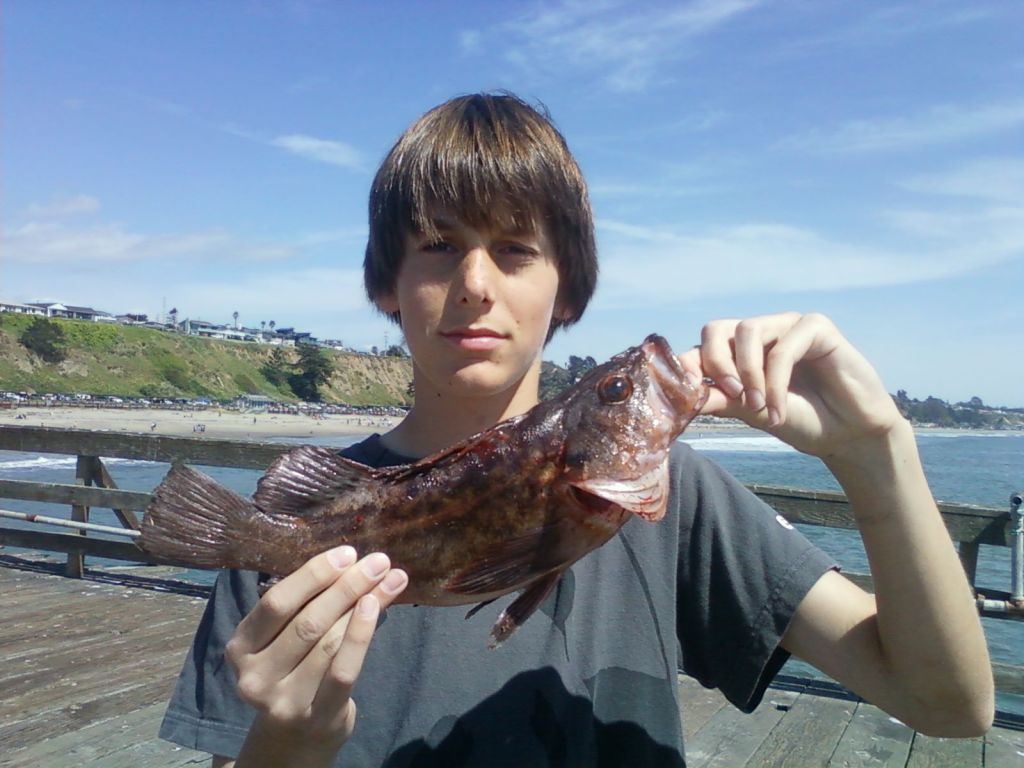
Brown rockfish
The waters will also yield a few sharks, mainly smoothhounds or leopard sharks (including a nearly five-foot-long fish in August of 2009), Rays too will show up including thornback rays, bat rays, and a few skates.
Although not a noted pier for large sharks, some years do provide decent action as seen in 2008 when large numbers of thresher sharks were reportedly taken over the summer months. Some years will also see a few species more common to the south, i.e., two shovelnose guitarfish were caught in July of ’06.
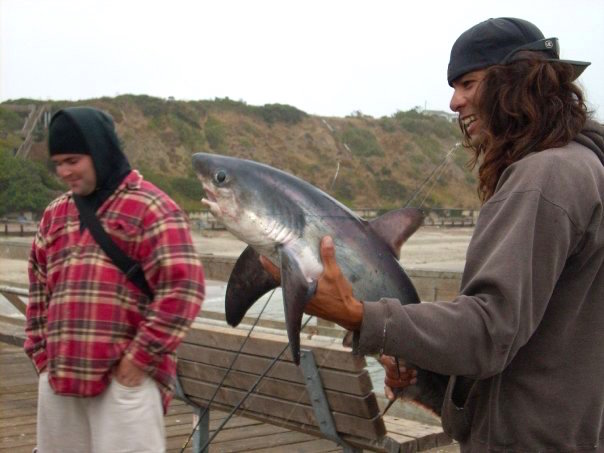
One problem that can exist is the overabundance of shiners (shinerperch) and bullheads ( staghorn sculpin). At times it is almost impossible to keep the shinerperch off your hook, especially if you are using small pieces of pile worm. The only alternative is to use larger hooks and different bait but realize you will catch less of the other smallish fish. Of course when you latch on to that 30-pound halibut or striper using your live shiner as bait, you will thank the good Lord for their abundance. After all, small baitfish like the shiners is what attracts the larger halibut, stripers and salmon. And there is a reason why the regulars have two rods—their larger rod for the halibut and their light action bait rod.
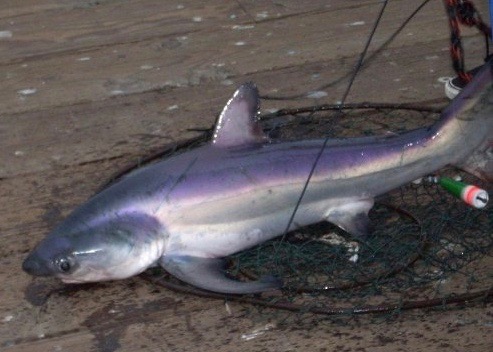
A thresher shark but just a baby
The Pier Rats Speak
Date: December 14, 2001; To: Pier Fishing In California Message Board; From: pescare; Subject: Why Seacliff Pier Scares Me
I was around 8 years old and fishing with my dad about midway out on the ship as all of it was still open at the time. There are two men fishing to our left about 30 feet further out.
All of a sudden, WHACK! I’m seeing stars and feeling EXTREME pain on the side of my head. One of the guys had been casting a big plug and somehow managed to cast 90 degrees to his right and imbed both sets of treble hooks in my scalp just above my left ear. I’m screaming from the pain and blood, my dad’s frantically trying to help me but I wasn’t exactly keeping calm and still for him. The guy that did it never even came over to help or see if I was okay. The other one did, and explained that the one who did it was not quite “stable” and doesn’t really understand what he did. Fortunately, the barbs were not deep in my skin and they were able to free them without cutting or pushing them through. I was quite happy about that.
That, and two other events at the pier that summer added up to enough trauma to make me argue to go to Capitola or Santa Cruz for years every time dad wanted to go to Seacliff.
Number two was the time we were playing in the water and I had to go to the bathroom. Dad takes me to the outhouse and waits outside while I’m in there. Don’t ask me why, but for some reason I was wearing cut-off jeans and no underwear. Okay, I’m all done and start getting everything back together to go back to the water. I start to zip my shorts and the zipper jams about halfway up. YOW!! Guess what it jammed on! Again, I’m screaming and dad’s pounding on the door trying to get in because he has no idea what’s going on. I finally gather my senses enough to open the door and after about 5 minutes of dad yanking on both the zipper and my ummm.., errr, you know, he frees me. Oh man, I was hobbled for days.
Number three occurred while we were playing in the water also. I’m about knee deep in the surf playing with my sisters when I feel what I thought was a towel or shirt or something like that wrap around my foot and ankle. I kicked it off but couldn’t see it due to all the sand stirred by the waves. I don’t think anything of it until about 30 seconds later my skin starts to feel warm where it hit me. Thirty seconds more and the warmth turns to tingling, then to fire. I run out of the water to my parents and we all see that my foot and ankle have about a million red dots on them. Jellyfish! Turned red, swelled up and hurt like hell for part of the day, but I was okay after a while.
Whew, my various body parts are starting to hurt just from digging up these memories. Okay, think happy thoughts…. Think happy thoughts… Ed
Date: March 4, 2002; To: PFIC Message Board; From: jason chin; Subject: Seacliff pier etiquette
Seacliff: fight or don’t fight? With the beautiful weather and the past success I’ve had at Seacliff for the perch I figured I’d head back out for another shot. I got out around 7AM and waited for the gate to open, which they finally opened around 8. It was low tide when I arrived Sunday morning so I decided my best shot would be to fish off the end of the pier along the cement boat in the deeper water. Away I’m fishing with no success waiting for the water to rise when I notice a school of 5 salmon swimming near the surface on the south side of the pier. They dwindled around for a few seconds and then were off again. A wonderful sign considering the season opens at the end of the month. The pier is starting to fill up around 9AM and still no action, so I decide to wait it out till the top of the tide. I have 2 poles with me, one is in the water and the other isn’t but is propped up against the rail.
At 10:30 a father and son arrive and decide the best spot on the pier would be in between my two rods. One is placed along the boat and the other one that’s not in the water is propped against the rail so no one can cast over my line. I don’t say anything thinking hey it’s cool they’re probably going to be fishing straight down off the pier so I’ll let it ride, even though the spot between my poles wasn’t even enough room for one. Just about pushing me out of the way, the father turns to his son and says, “Hey we got a line in right here (referring to my pole) and we’re either going to have to cast over it or someone’s going to have to reel it in” and looks at me! I blinked in astonishment. Not believing the words I just heard, I said, “You come out here at 10:30, stand in between both my rods and think I should reel in because you want to fish here?????” He tells me “Yes” and smiles.
Obviously wanting a confrontation, which was pretty dumb knowing that in a twist of my wrist I can throw this guy in the drink and send his kid running home crying wondering what happened to his daddy. For some reason I didn’t, I thought of the trouble I’d have to go through and maybe the costs ($$$) I would have to pay if I did such a thing. Anyways, the guy proceeded to cast over my line numerous times and smile until I finally had enough and decided I better take off because it was about to get ugly. I left very upset knowing I did the right thing but really deep down would’ve liked the satisfaction of “setting this guy straight”.
I know by looking at what he was using he wasn’t going to catch anything with all the luck in the world so I guess that’s a little satisfying. If that loser of a father happens to be reading this for some odd reason I’d watch out because many people I know will toss fools over for that kind of crap. Way to teach your kid how to do it. The kid by the way was far more intelligent then his father not once did he even consider throwing it over my line. He can thank his son for one more reason he didn’t get tossed since I didn’t want to ruin his day for his father’s stupidity. Jason “bayrunner”
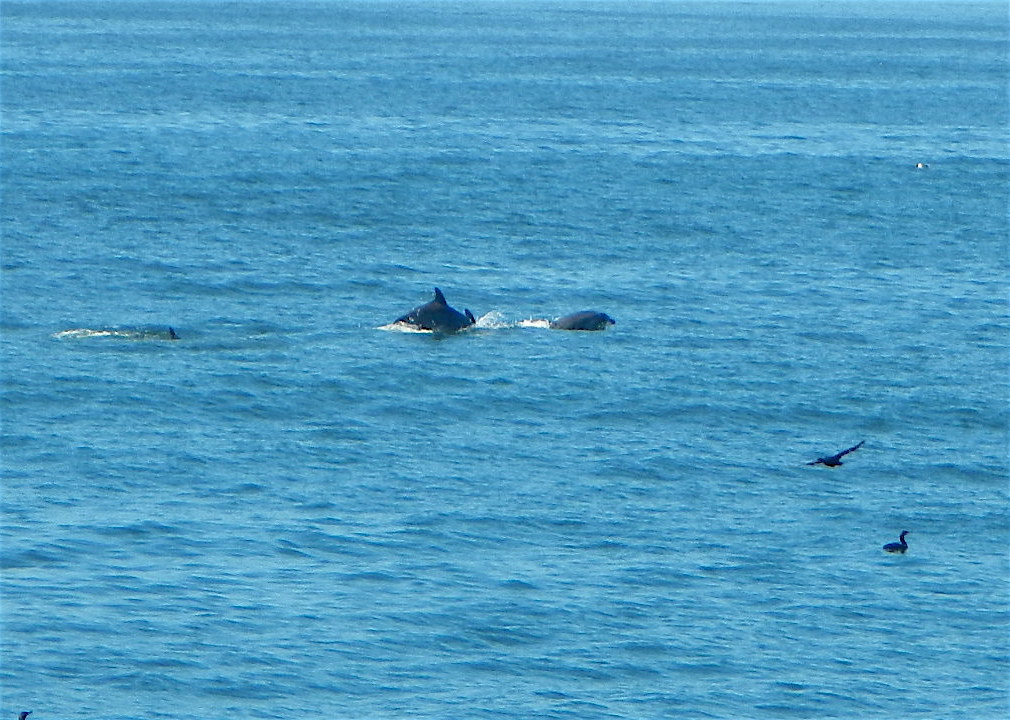
Dolphin are a frequent companion when schools of baitfish are in the area
Date: April 22, 2002; To: PFIC Message Board; From: jason chin; Subject: Seacliff
April is just great. Plenty of fish all over the place… Started the weekend early and hit Seacliff on Thursday and Friday. The wind was blowing on those days so the salmon got a break from me, for I don’t care to have to play the beat the wind game. Brought a perch rod and my live bait gear in case some bait came in. Never found any bait either day but the perch fishing was fantastic. Had to have gotten about 20 black perch (locals call them buttermouths) and a few large rubberlips one pushing 3-lbs. Pile worms on a slider fished along the cement ship did the trick. Wind picked up early as expected and I smiled as I stood upon the stable pier and peered out at the whitecaps. Two whales also made a showing on route towards Capitola. Only got a quick glimpse at them so I couldn’t tell you what kind for a perch was engulfing my worm at the time.
Headed back on Friday and nailed a couple of buttermouths but the fishing slowed dramatically along the ship from the day before (maybe their lips were sore). Anyways no worries the calico perch and rubberlips moved down towards the breakers and were found willing and ready underneath the pier. Fished worms again and sand crabs and got quite a few. Met a lurker of the board on the pier who was a nice fellow hopefully he will start posting soon so I know what’s going on when I’m not there (hint, hint). Also saw roughly around a 25-lb rogue striper making a round around the pier and two leopard sharks working the area also. All we need is some bait inshore and the fishing should take off around there. Jason “Bayrunner” – out.
Date: December 2, 2002; To: PFIC Message Board; From: jason chin; Subject: Seacliff pier damage
Had to meet some friends over in Santa Cruz yesterday and decided to take a look at the battered Seacliff pier. A large metal storage container washed up from somewhere during the last storm crashed and knocked out several pilings on the north side of the pier. There was a decent sized gap with no supports and two pilings still connected that now swing back and forth each time a set hits. It doesn’t look good and looks to be quite a bit of work to repair. The cement ship itself looks like it even separated more in the middle of the ship and the end seems to have sunk down even more. I really wonder if they will not close her for good. It’s going to take a lot of voice I believe to convince repair work to this structure. Disappointed I left and went to Sno Whites for breakfast. I saw one of the local pier rats there and chatted for a bit. 9 pilings total were knocked out and no repairs will even be considered until the storm season is over. Let’s hope she hangs on.
— The pier was closed for a period of time —
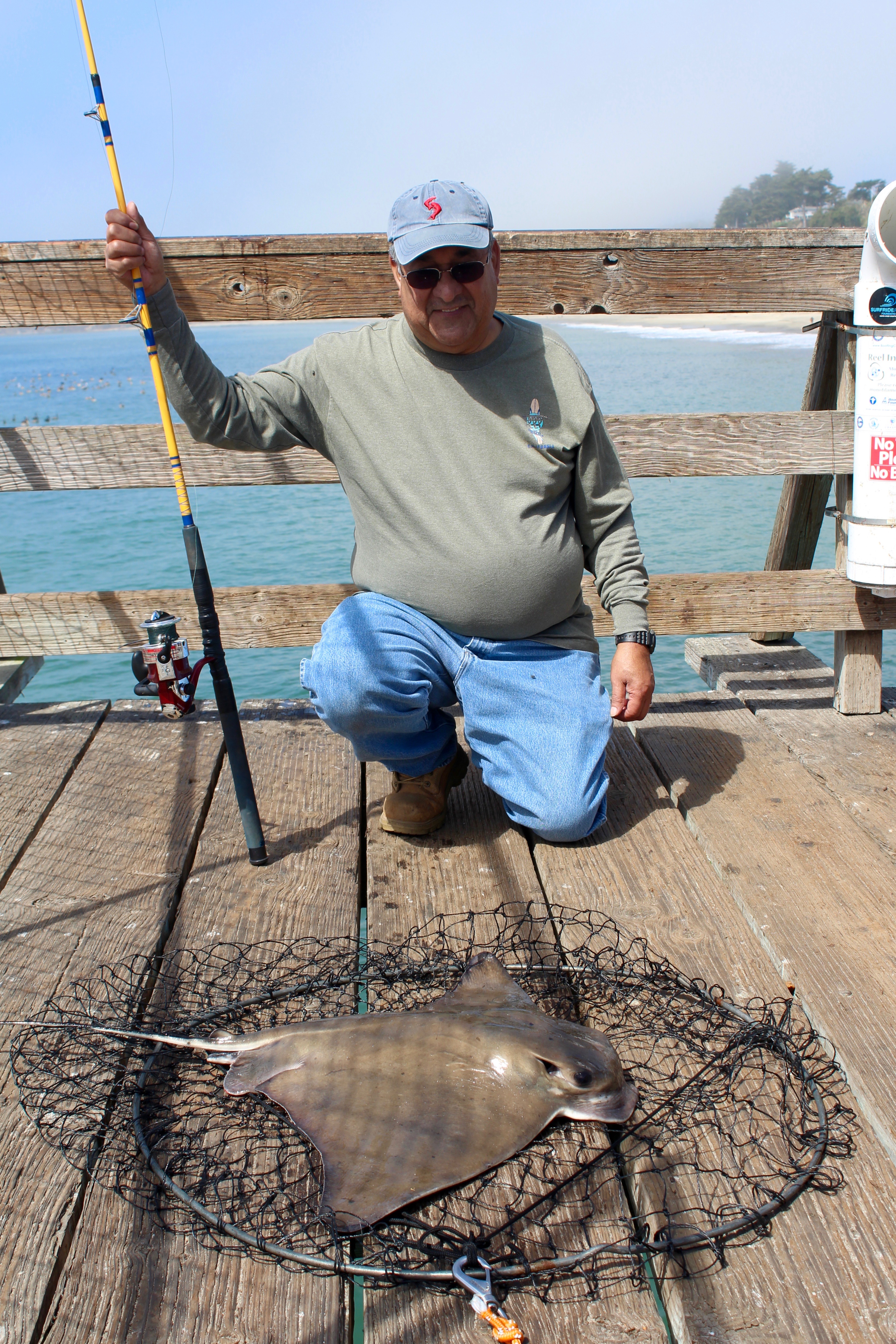
A small bat ray that I netted for an angler during a visit in 2018
Date: February 6, 2004; To: PFIC Message Board; From: snakeman70; Subject: Seacliff Pier
Started off at 8:00am. Very high and rough surf, not windy but definitely cold. Two other fishermen were present, each one at a corner facing the cement ship. Both men were after Rockfish, they were using sliders with #3 or #4 Pyramids. Looks like they were both using Pile Worms attached to a #4 hook with a pink bead. They didn’t seem to be having much luck.
I set up on the right side, next to the fisherman in the corner. Set my ABU 7500 w/ Ugly Tiger with a high/low. #1 hooks and a chunk of anchovy, #3 weight. Surf was too rough, so moved up to a #5 weight. Immediately started getting nibbles. After loosing bait two times, figured it must be White Croakers or Perch. Decided I need to use smaller hooks.
Changed over to #6 hooks and put on a pieces of Anchovy with a squid trailer. Not more than 30 seconds in the water and Bam! Found a small Barred Surf Perch. The action was hot for about 1 hour, same spot about 20 yds from the pier. After that hour, the Walleye Perch, Speckled Sand Dabs started to come out. Averaged a fish about every 10 minutes.
They did a great job fixing up the pier. New, pressure-treated planks, new fish cleaning sink. The cement ship looks to be in poor condition. The stairs that used to lead to the ship have been removed and Danger Signs posted all over to stay off. Anyway, a fun morning of fishing. Glad I decided to take the day off from work and go back to the place my dad taught me how to fish.
Totals: 12 Barred Surf Perch, Biggest was 12” kept 4 of them for dinner — 5 Walleye Surf Perch — 3 Speckled Sand Dabs — 22’ of Seaweed
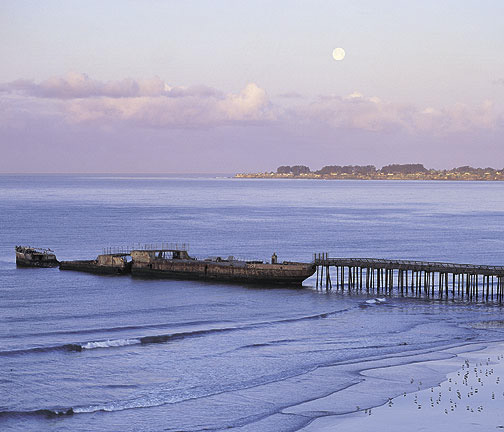
A pretty shot!
Date: May 20, 2005; To: PFIC Message Board; From: pescare; Subject: Disturbing news regarding Seacliff Pier – Again
The large swells and high surf of two weeks ago were not kind to the pier, and it is again damaged and is now closed. Several pilings were broken out as you can see in the picture, and there is a noticeable sag in the deck. There is a temporary fence up now blocking the damaged area and I was told by the guy at the gate that the rest of the pier would be opened within days. Of course, that leaves very little fishable water under the accessible part of the pier.
I was not able to find anyone at the park who had information on the pier’s immediate and long-term future, and in fact, had to invite two docents to look out the window of the visitor center to see for themselves when they argued that the pier was open. I’ll report back here with whatever I can find about this. Lets cross our fingers.
Date: June 24, 2005; To: PFIC Message Board; From: climberb9 ; Subject: Seacliff Pier, June 23rd
Its time for the Seacliff go-ers to get out their Sabiki’s, tie on a live bait rig on a bigger pole, and catch some stripers! Went yesterday and caught my first from a pier ~26” and 5-lb’s with nice straight stripes on a live anchovy pinned through the neck twenty feet out Great day; also saw two others caught.
Date: May 1, 2006; To: PFIC Message Board; From: kaleo; Subject: A very good sign
I hit Seacliff yesterday a.m. hunting halipers with swimbait, spoon, and grub. Got into a decent walleye bite, but that was it. The morning low tide was blanketed with a heavy marine overcast, which broke into gloriously sunny and warm beach-going weather by about noon. Strode the pier for a look-see about 1pm, nothing bigger than perch coming over the railing. Stripers and ‘buts don’t seem to be showing yet. But there was a decent school of baitfish (smelt?) just outside of the surf on the south side of the pier, and a large school of anchovies moved in on the north side at the end of the pier. Mostly pinheads, but a few bigger models were in there too. Regrettably, nothing seemed to be hassling them at the time.
On an August evening several years ago, I was at Seacliff when a similar school of anchovies came by the pier. It was dusk and here too, nothing seemed to be hassling them. Then suddenly they went into panic mode: a large fin and tail broke the surface. And not once, but three times a magnificent thresher jumped clear of the surface, less than 15 yards from the pier. There is nothing like watching a large predator show you how it’s done.
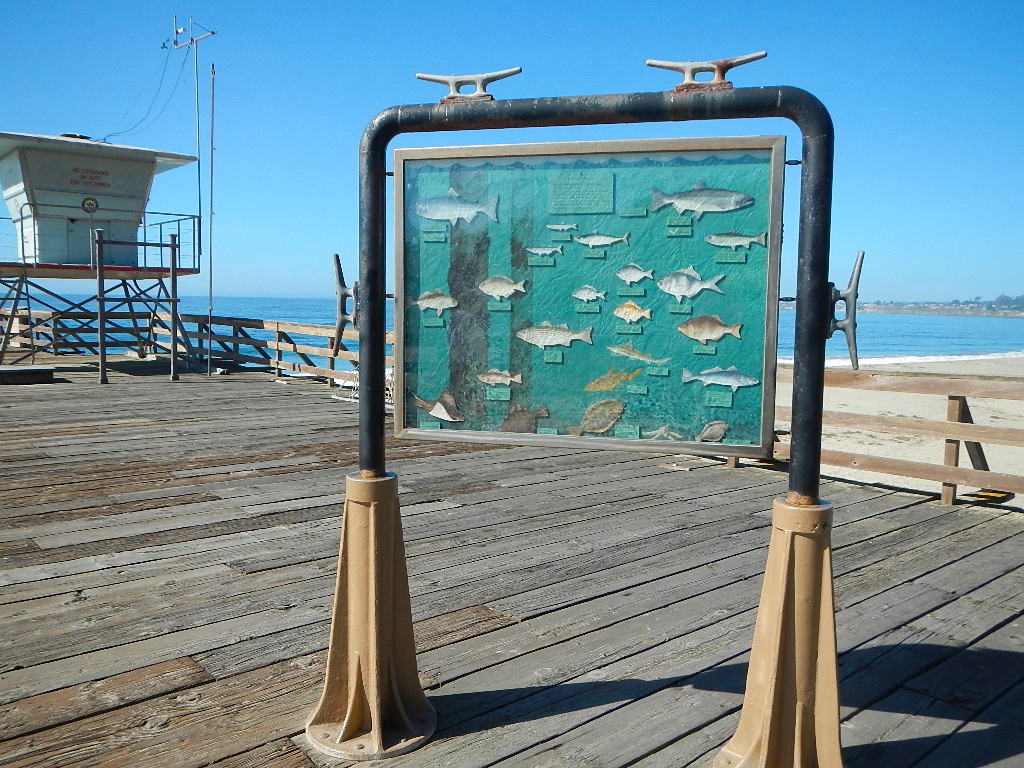
So that’s what I caught?
Date: August 15, 2006; To: PFIC Message Board; From: Sin_Coast; Subject: Seacliff Pier, 8/13
Although it is closed now, I remember fishing off that cement ship. There are holes in the middle of the hull that held various RF and you could just drop your line straight down to them…and casting off the end of the ship was the best way to catch halibut. However, I think it was a good idea to close it off to the public, considering how dangerously unstable it is now. Last couple times out I’ve only caught small BSP and walleye/shiner surfperch.
Date: April 9, 2008; To: PFIC Message Board; From: pierrat80; Subject: Seacliff pier 4/9/08
I got to the pier around 2:00, armed with every type of bait you could think of, frozen squid and ‘chovies, live ghost shrimp and pile worms, and some raw market shrimp. I had a first timer with me and I really needed her to catch a fish. I threw out just about every combo of bait I had on a couple of rods rigged with surf leaders and #2 bait holders, for one average sized perch on a whole ghost. Here’s the kicker, it’s now about 6:00 and I am about ready to leave, start giving away unused bait. I had totally forgot about my pile worms, maybe used one all day, so I go over to this dude ask him if he wants them, this guy got super excited over them, showing them off to his buddies. He rigged up a hi/lo with half a worm on each hook, and bam not more than 3 mins in the water and he got a nice walleye perch, rig up again, same thing. In the span of 10 mins he had a total of six perch. So I steal a couple worms back rig the missus, let her cast it out, and before I could finish setting up my rod, she had fish on. To see the excitement in her face, priceless. Get her back in the water; get myself in the water, bam, she doubles up. Never been fishing before and she was setting the hook like a champ. Well to make a short story long, we released a total of 13 walleyes between the two of us, 7 were hers. Perch bite was red hot on pile worms. Must be like perch crack or something.
We were fishing right before the breaks, and it didn’t seem to matter how far away from the pier you put the bait. The bite was wide open. I tried throwing some grubs in the surf for nada, the only thing that worked were pile worms. Heading back out there with pile worms. Might bring a bunch and sell them off to pay for gas, locals said you can’t find ’em out there.
Date: April 10, 2008; To: PFIC Message Board; From: pierrat80; Subject: Seacliff pier
Perch bite is smoking hot right now, well… for the girlfriend it is anyway. I can’t believe it, only her second time out fishing ever, and she was just destroying the walleye perch, same set up as the day before, hi/lo with pile worms. She had at least 20 fish in the first two hours, with multiple doubles through out the day. Got out there around 2:00 again, fished just before the breakers on the side with the lifeguard tower. There was a time she was pulling them in as fast as I could put worms on the hooks for her (yes I bait her hooks for her, she’s afraid of the worms bite). My rods went neglected for at least an hour, but even when I did get them baited and in the water, they often went untouched. Anyways I think the final score went: 30-35 for her/ 4-5 for me. She definitely outfished anybody on the pier this day, even the regulars were in awe, and wanted to know what her secret was. This girl was born to fish, she can cast a pole like she has been fishing her whole life and sets the hook at the slightest nibble. We kept 7 pigs for some lunch tomorrow. Now that I got her hooked, I hope I can spend more time out on the water than I used to. Hope to meet some PFIC’ers out there sometime, I tell you watch her fish and you will never believe she had never touched a fishing pole before yesterday. OH yea, the girlfriend pulled in the only striper this day. It was super small, only about 6” but still exciting for both of us. I’m telling you, them pile worms are like crack for perch. They don’t stand a chance.
[The following was from one of our youngest (at the time) members of the Pier Fishing In California family. And yes, the weight looks a little bit high.]
Date: May 8, 2011: To: PFIC Message Board; From: HalibutSnatcher; Subject: Seacliff Skate
I went fishing yesterday at Seacliff for some stripers. I tossed a lure for nada. Then one of my friends shows up and catches some live shiners for us. So, I put one on and right at the top of the tide my friend’s pole gets bit. He sets it and the rod doubles with weight and somehow he was able to pull it up with his light striper pole and it was a huge skate! But then his line snaps and like 20 seconds later I get bit and I feed it line then I set the hook and it’s huge. In two min. I pull it up and it was the same skate. I fight for 15 min. So tiring, I almost lost it to a piling and we tried to net it but it was to difficult so we were gonna beach it. I gave my rod to my friend and ran down to the beach to help my other friend pull it in and so I could get a pic. We got it in and it was 120 pounds or more! Biggest fish I ever caught my and friend couldn’t even pick it up! I took a couple pics and my friend also had his nice camera and took some pics from the pier. Man that thing was so much fun. At the end we released back into the water. I caught it with my Ugly Stik Lite on a sliding setup with 20# p P-line cxx. Best day on the pier so far this year! Here are the pics.
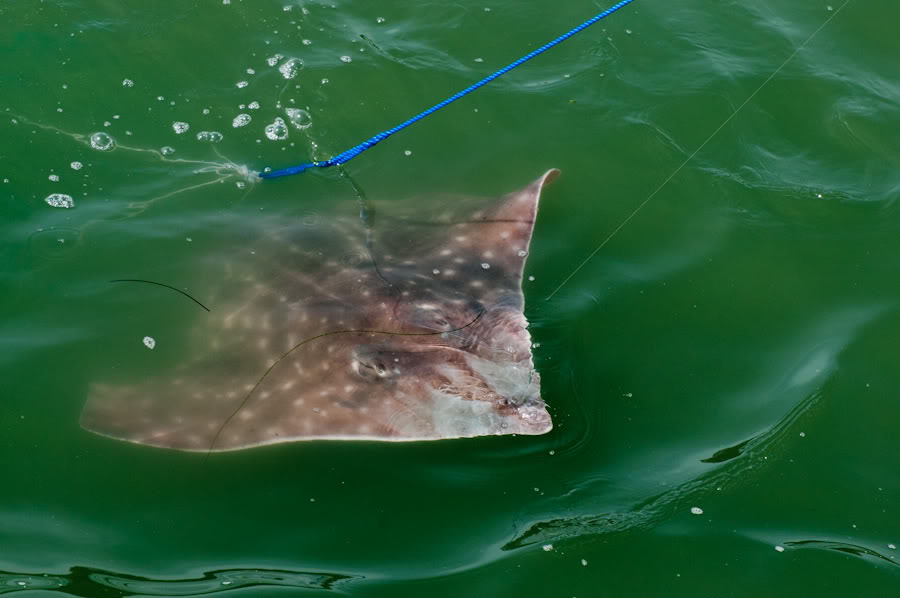
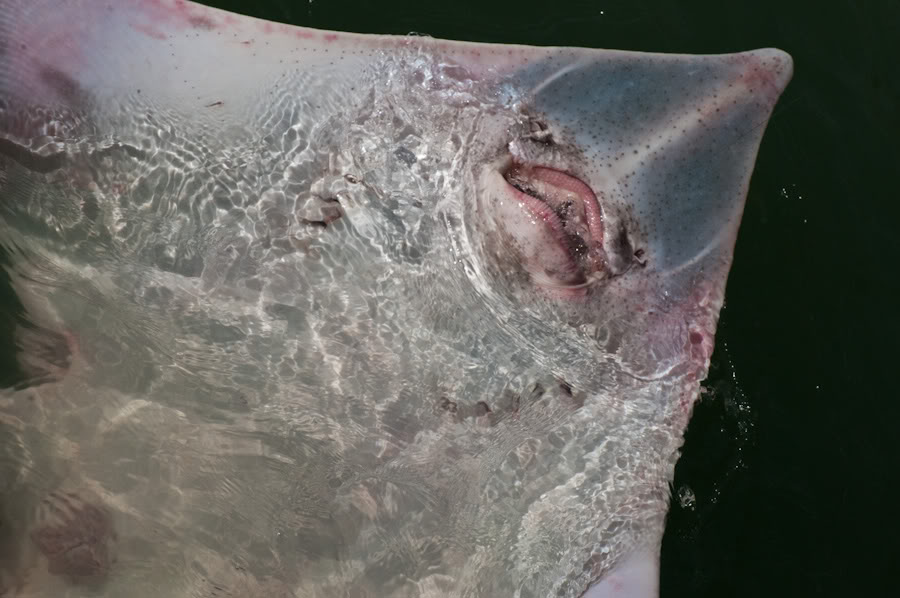
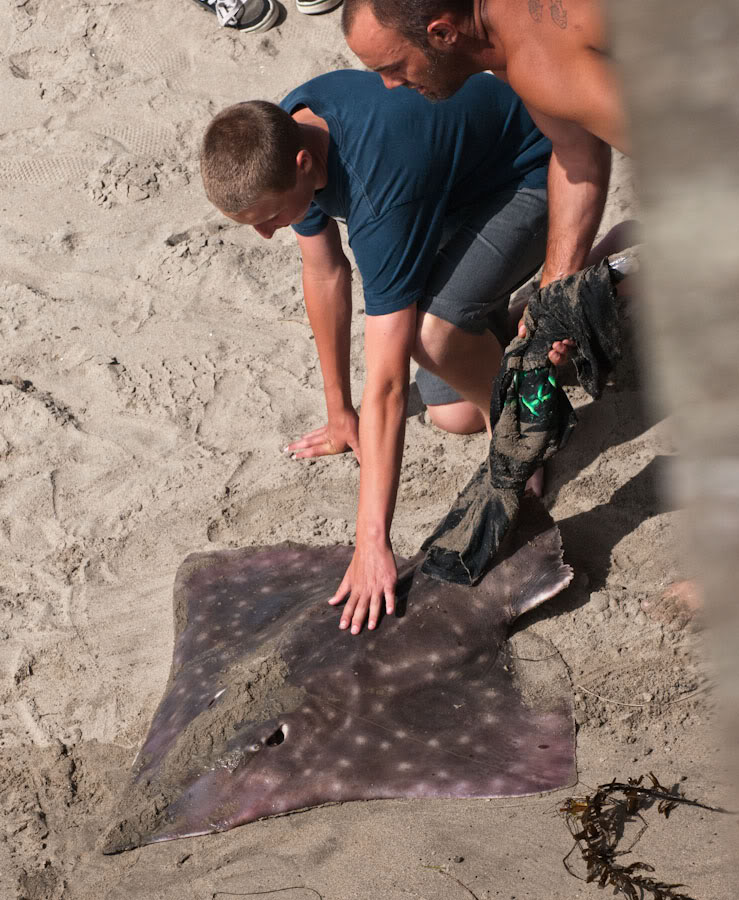
Potpourri — Perhaps more than you want to know about the Seacliff Pier
<*}}}}}}}}}>< — Fish surveys done by the Department of Fish and Game (2004-2009) showed 17 species at the pier (by number of fish) — Northern anchovy, walleye surfperch, barred surfperch, Pacific sardine, shinerperch, calico surfperch, white seaperch, jacksmelt, silver surfperch, pileperch, striped seaperch, white croaker, blackperch, cabezon, topsmelt, California halibut and redtail surfperch. Most amazing was the low number of white croaker which traditionally have been near the top as far as numbers at the pier. Also somewhat strange is the lack of any striped bass, sharks and rays. Unfortunately these surveys are very limited and dependent upon the time of the year and time of the day being surveyed, they can give figures that are somewhat misleading.
<*}}}}}}}}}>< — Although it may look much the same as in years past, looks can be deceiving. The punishing storms and “hands of time” that made the ship dangerous to visitors changed the entire nature of the pier for anglers. Prior to its closure, and a sturdy fence blocking access to the ship, anglers could fish in and from the ship itself. By in, I mean several wells on the deck of the ship that allowed an angler to drop a line into the bowels of the ship itself (and I would have loved to be able to dive down inside that old ship). Who knows what growths and strange species inhabit the interior rooms of that ship? Maybe gigantic wolf eels; perhaps a pair that has mated for life? Maybe large octopi, even though the only ones I’ve seen in the area are palm-size little creatures. What I do know is that there were rockfish, cabezon, lingcod and perch—a plethora of species—available while fishing on the ship. Anglers were presented two options. They could fish the shallow-water, sandy-shore area of the main pier itself, or fish from the ship that over time had metamorphosed into an artificial reef of sorts and now replicated a rocky-shore milieu. Two distinct environments connected in a unique manner. My last visit to that ship and its wells was in 1994, a visit that resulted in several rockfish and perch. Ah, those were the days! But they’re over.
<*}}}}}}}}}>< — This is the only pier in the state where I have witnessed a wedding taking place, an event that certainly gives a little variety and added excitement to the typical pier fisherman’s day. The wedding I observed included a small band, flowers, a Navy captain acting as minister, and of course Prince Charming and his bride. Since the wedding took place on the cement ship I guess it was legal. By the way, conversations with anglers afterward indicated such weddings had occurred several times on the old ship (and it certainly provided some unusual wedding pictures).
<*}}}}}}}}}>< — In 2004 Pier Fishing In California held a Get Together at the pier, which turned out GREAT! Good food, fair fishing, and great company. A few pictures:
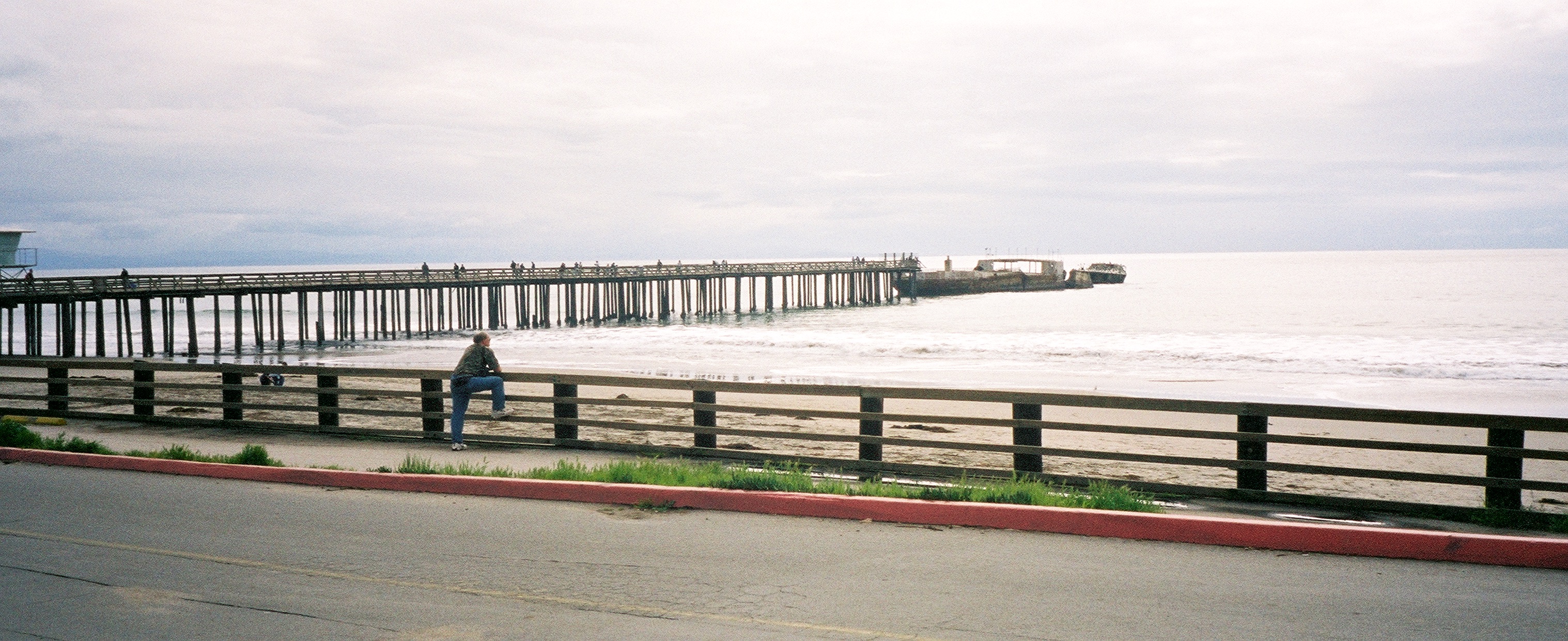
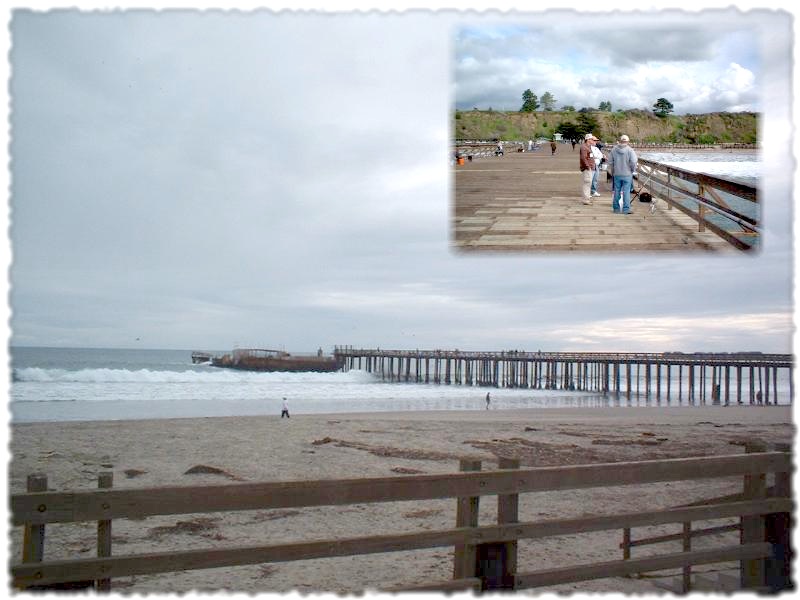
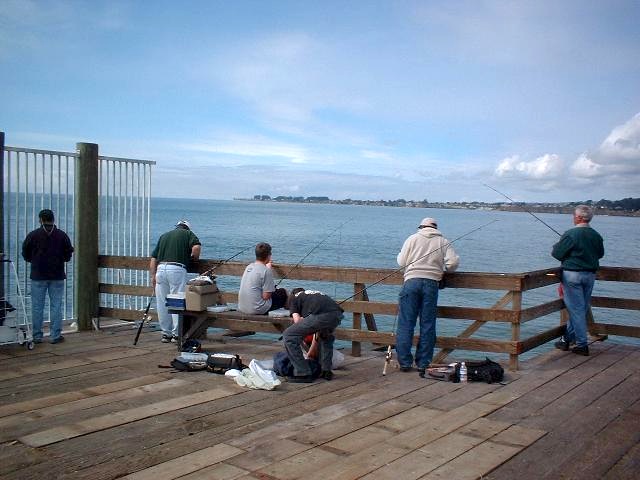
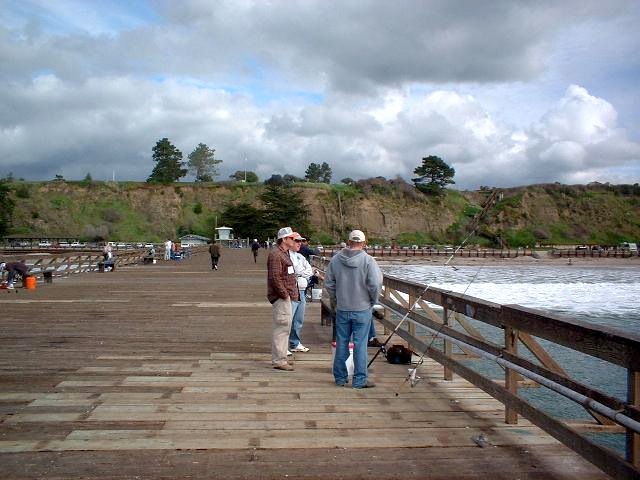
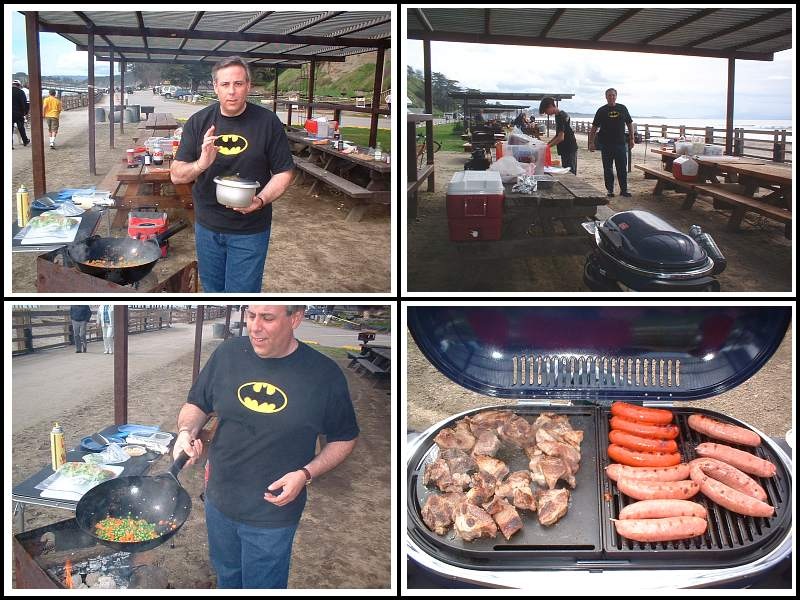

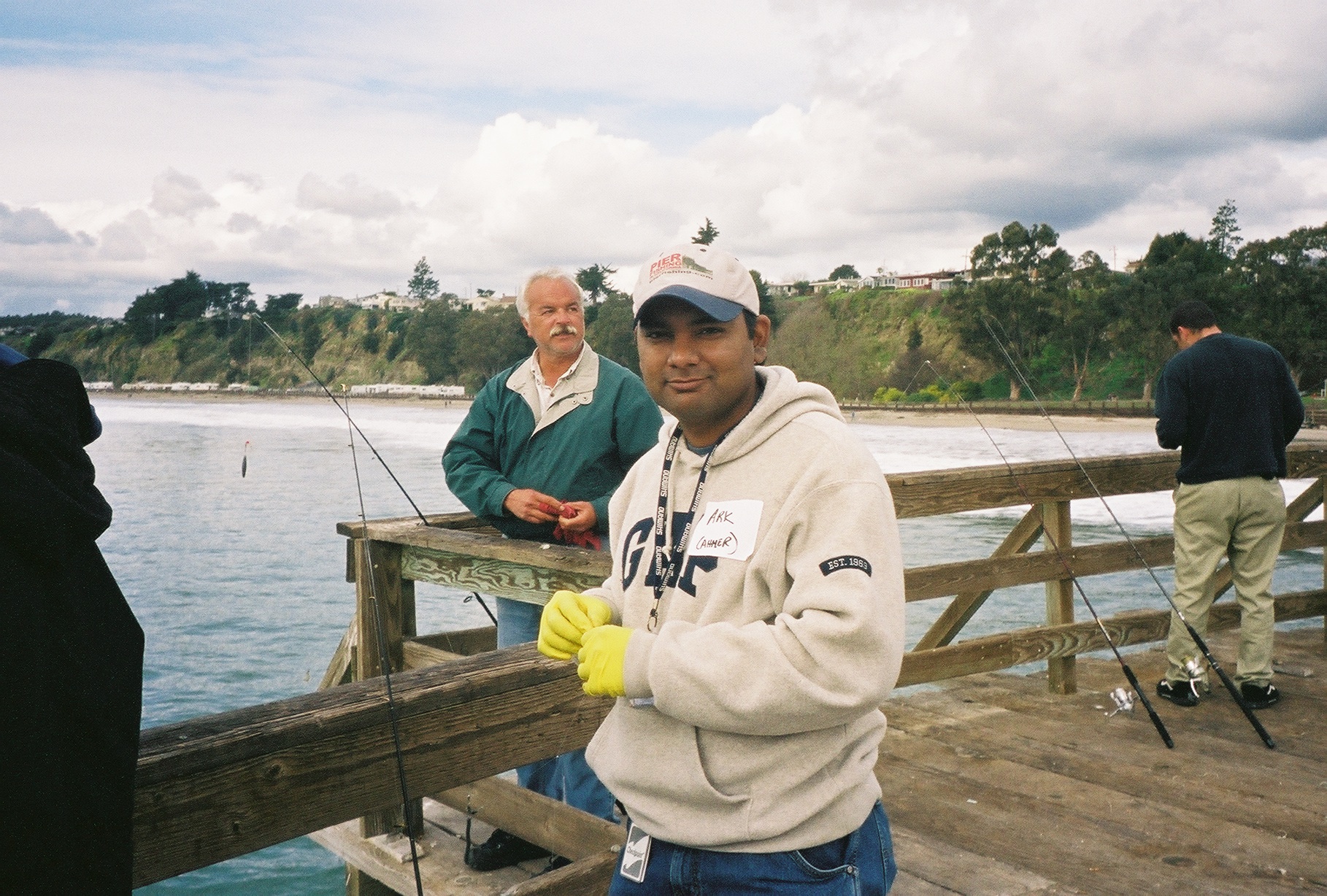
Ark
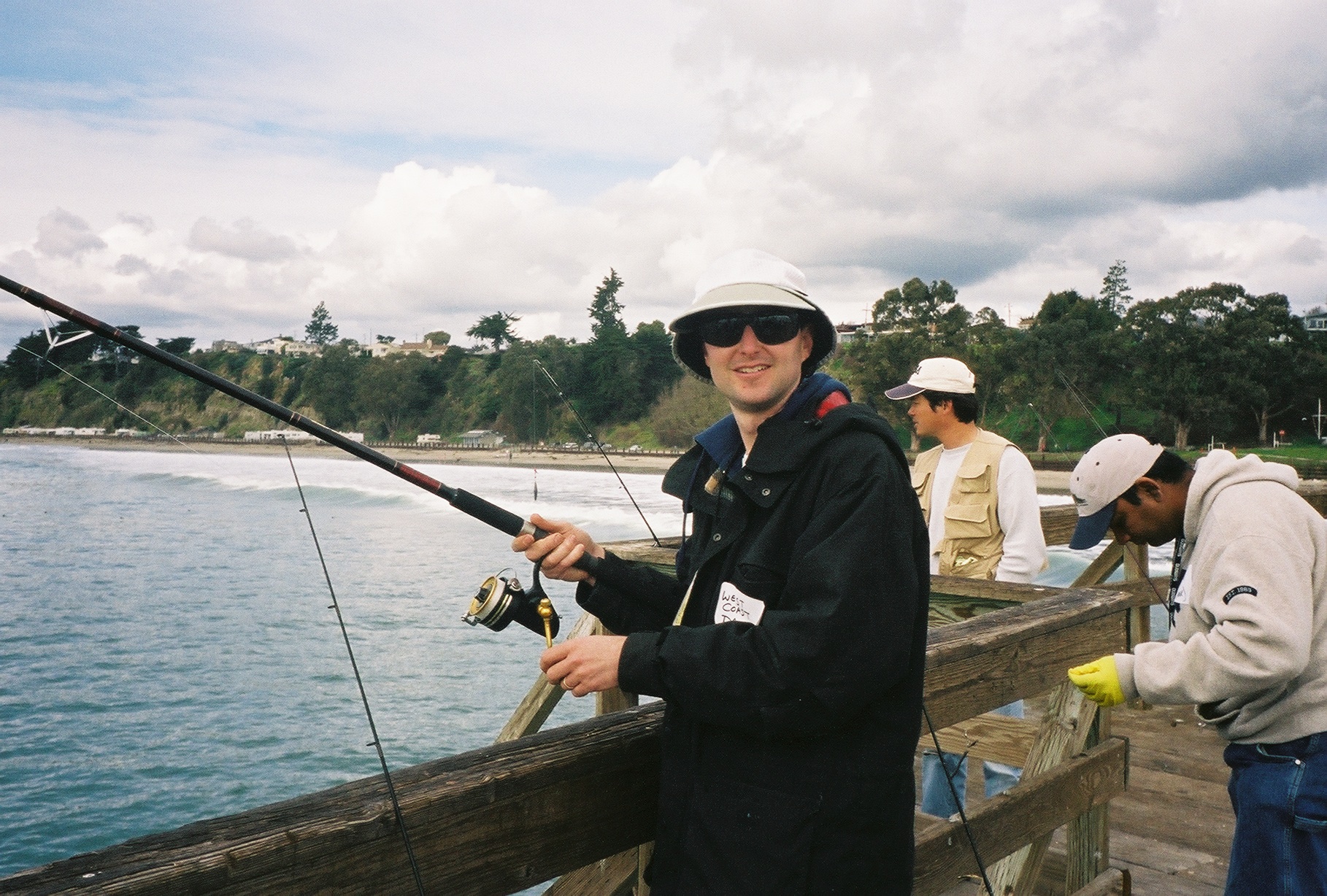
Westcoastdave
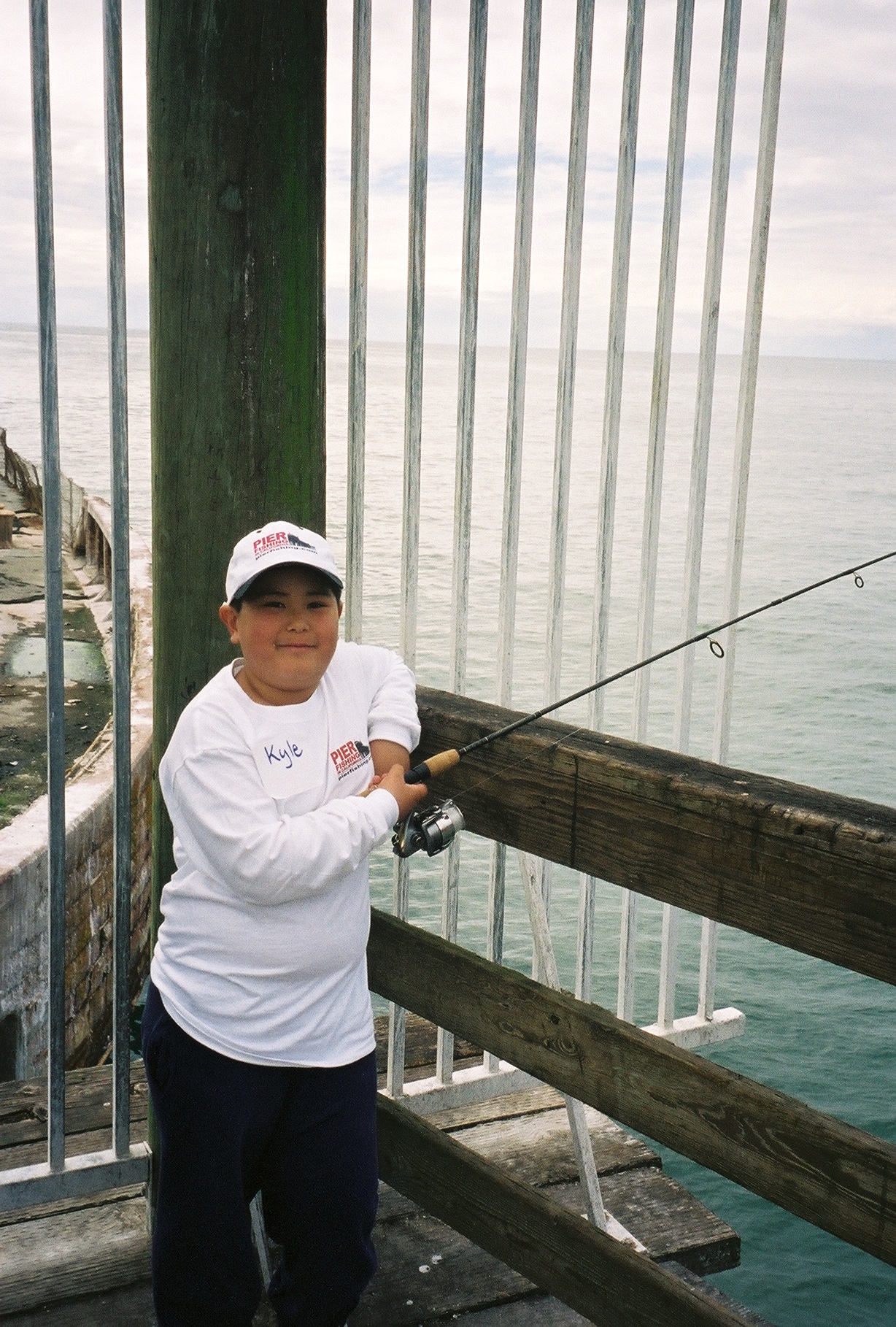
A very young Kyle Pease. It’s hard to believe he’s now a senior at Berkeley
<*}}}}}}}}}>< — Never give up the fight to educate the public. On one of my trips to the pier I pulled up a bullhead (staghorn sculpin) and as I was unhooking it a teenager walked over and asked what I was going to do with it. When I said I was going to throw it back he asked me if he could have it. I said maybe. What was he going to do with it? He replied that he always squashed bullheads—he flattened them with his shoes. “Why,” I asked? His answer was curt—“because they were no good.” I then asked him if he had ever seen a striper or other large fish at the pier and if he knew why they would be around the little pier. He said he’d seen some stripers but didn’t know what I was getting at. I then explained that bullheads were one of the bait species that attracted striped bass and without bait species there wouldn’t be any of the bigger species. He said he hadn’t really considered that and as we talked I think my short homily may actually have convinced him not to squash bullheads—or other small fish. Maybe it was just opening the eyes of one angler but you have to start somewhere.
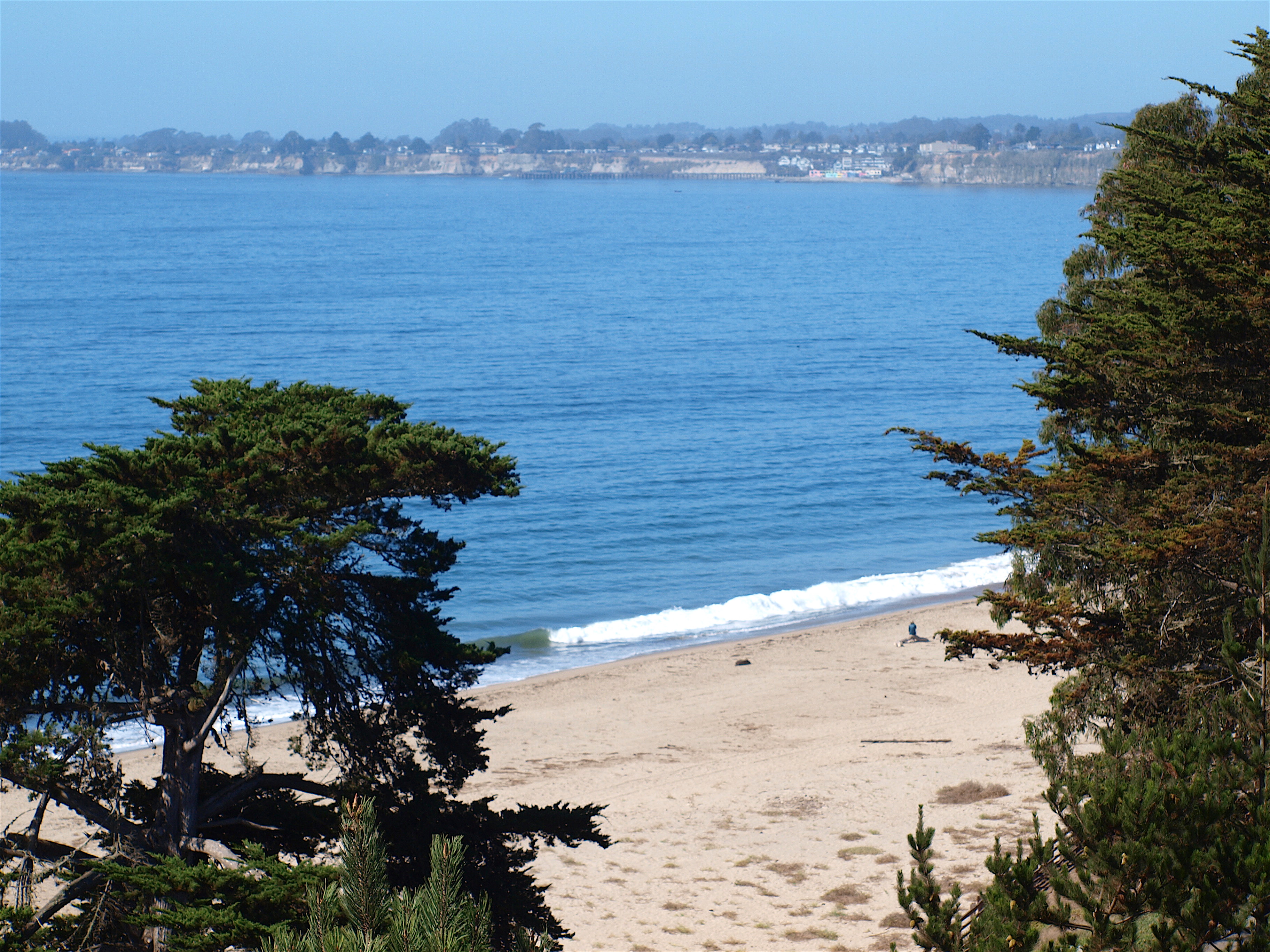
Looking north toward Capitola and Santa Cruz; you can just barely see the Capitola Wharf
<*}}}}}}}}}>< — California Fish and Game Bulletin #96, issued in 1953, says the following for Aptos—Located on Monterey Bay nine miles east of Santa Cruz. The town is inland a mile or two from the waterfront. This is a resort region with much interest in sport fishing on the bay. The beach area was established as a state park in 1933. The novel feature is the concrete hull of a ship that was grounded in 1927 on the rocks off the beach. A wooden pier was built out to the ship so that the deck serves as a sport fishing wharf. The park is so well patronized that parking space for a car is at a premium. There has been no record of landings of commercial fish in the last two or three decades but 60 years ago (late 1880’s) after the coming of the railroad, Aptos ranked third of the fishing ports of the county. Rail shipments of fish went to San Francisco from this port. Still later, local Pismo clams were peddled to nearby towns and from stands along the highway.”
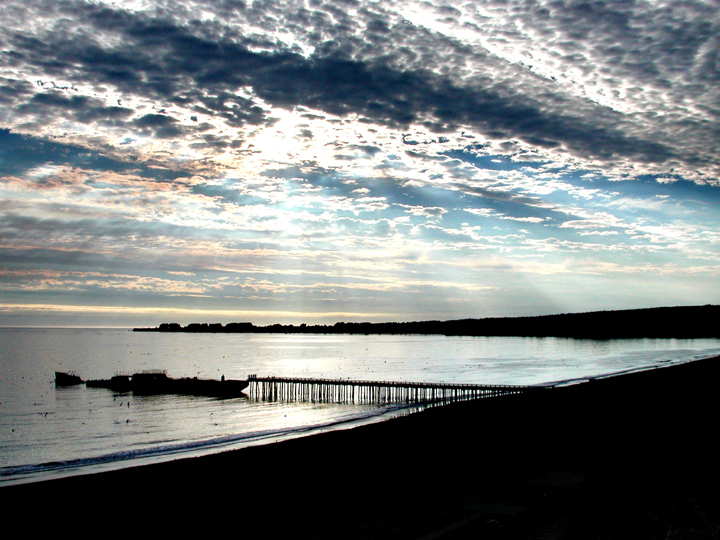
Nice pic!
<*}}}}}}}}}>< — The scenes described below startled me the first time I saw them and though I’ve now seen them several times, it’s still an amazing sight and a reminder of the power of Mother Nature.
Migrants Converge On Waters of Bay
It looks like a scene out of Alfred Hitchcock’s movie `”The Birds.’”
In the late afternoon, thousands of little black birds come in off the ocean and descend on the surf zone at a Santa Cruz County beach. They swarm like a cloud of locusts. They spiral and squawk and churn the water white in their delirious diving for anchovies. Then they quit the hunt in formation, patrolling the shore in an endless superhighway of beating wings.
To those who frequent Santa Cruz County beaches, the feeding frenzies of the sooty shearwaters are a familiar and freaky summertime spectacle. `”It’s pretty weird,’” said Eric Martin, 16, who surfs at Seacliff State Beach. `”I’ve been out there surfing when they’re just like right out there. There’s hundreds of them circling.”
The sooty shearwaters are visitors from down under. When it’s winter here, they breed in Australia and New Zealand and other distant parts of the Southern Hemisphere. Each year, these birds—which are slightly smaller than mallard ducks—fly thousands of miles across the open ocean to summer along our Pacific Coast—and to gorge on anchovies and krill.
`”They fly 7,000 miles or more,’” said Baldo Marinovic, a marine scientist at University of California at Santa Cruz. `”It’s a staggering distance.”
In Monterey Bay, their summertime population is estimated at potentially 2 million, Marinovic said.
This comes as no surprise to Russell Berry, 77, who lives three blocks from the beach at Rio Del Mar and strolls down to the sea wall every evening. “Sometimes they’re so thick on the surface, you can’t see the water,” Berry said.
During the day, the shearwaters disperse across Monterey Bay to hunt for fish. But in the late afternoon they head for protected beaches, where they roost on the water at night. The two beaches they seem to prefer are Seacliff State Beach and Twin Lakes State Beach on either side of the Santa Cruz harbor.
Settling down for the evening is preceded by several hours of plying the coast in formation in a long, black trail. And if the anchovies are running, there are spectacular feeding frenzies joined by pelicans and sea gulls.
To some, these orgies win hands-down over other California wildlife displays. “They work in spirals like tornadoes. When they’re diving into the water, it sounds like a waterfall,” said George Gray, an ecologist for the Santa Cruz district of the California State Parks. “I see people standing on the edge of the beach in awe. I’ve stood there in awe myself.”
—Maya Suryaraman, San Jose Mercury News, August 6, 2001
Note No. 7. If you happen to visit the Aquarium of the Bay, at Pier 39 in San Francisco, you may see a fish transported from Seacliff State Beach. It’s “Charlie the Swell Shark.” It seems that in 2006 when Charlie’s egg case (aka mermaid’s purse) was found on the beach it was moved to the Visitor Center’s aquarium. As happens, Charlie soon emerged from the case as a healthy 6-inch boy fish and started to do what all young ‘uns do, he started to grow. Eventually he grew to be a strapping 18-inch specimen and that fact, together with the disappearance of another fish in his fairly small, 150-gallon tank, convinced the staff that he needed a new home. Perhaps they could have released Charlie back into the ocean but instead they sold or donated (not sure) Charlie to the San Francisco aquarium in 2008. In September of 2008 the staff had a public “farewell party” for the popular shark before he headed north to his new home. There he was able to join seven other brethren swell sharks. See you in “Frisco” Charlie.
Charlie’s story nearly duplicated that of another swell shark whose egg case was discovered on the same beach in 2005. That shark, named “Riley,” also outgrew the confines of his tank; he was eventually moved to the Long Marine Lab at the UC Santa Cruz Marine Science Campus. Interestingly, both sharks had the same birthday, July 17, the day they emerged from their egg cases.
Note No. 8. The Festival of the Cement Ship is held annually on the first Saturday in June (usually from 11 AM-4 PM). All of the normal activities of such events are present: music, food, games, and crafts, but here you can also do a little kite flying on the beach. It’s a good event but also crowded.
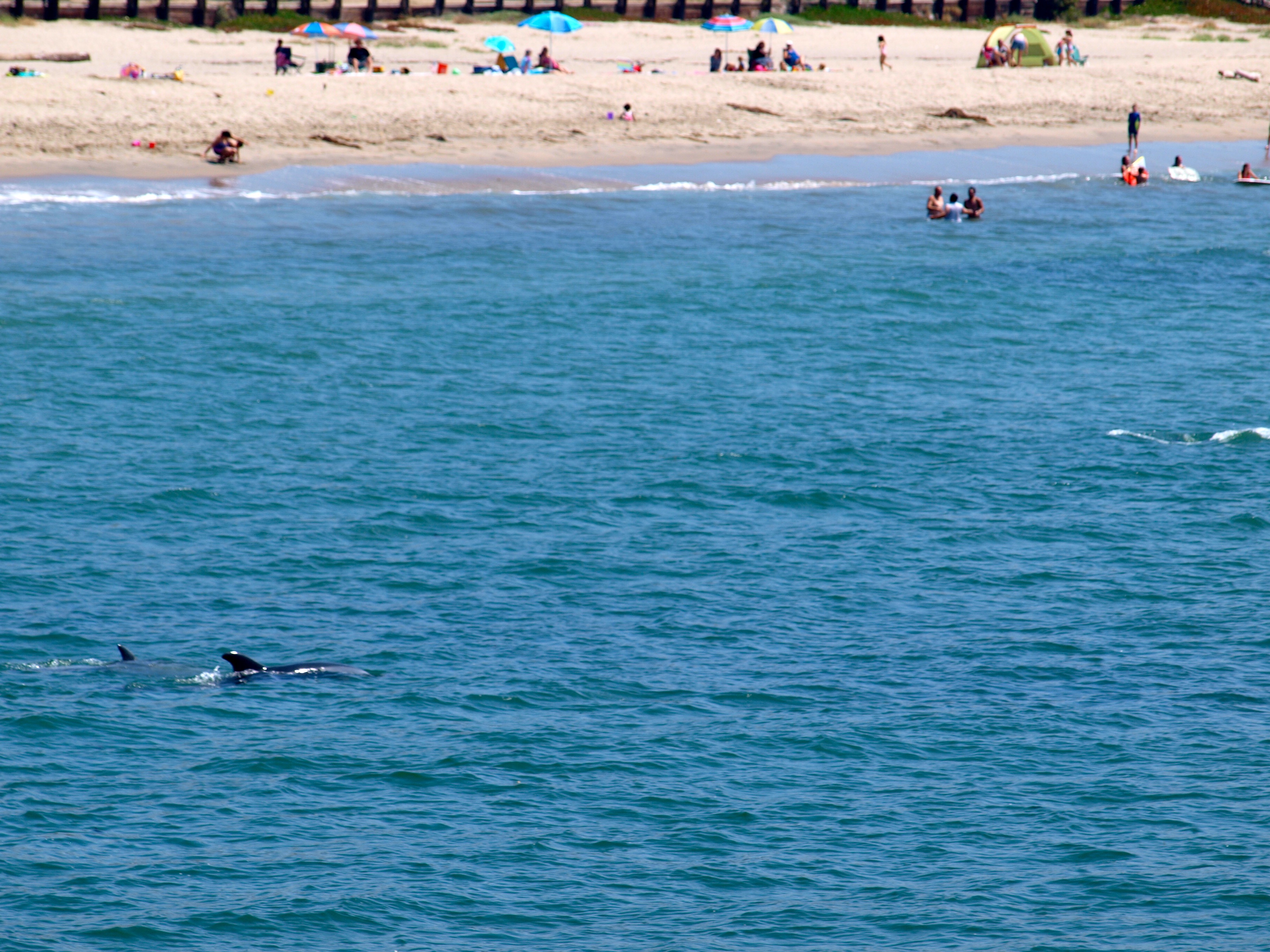
Dolphins, not sharks!
<*}}}}}}}}}>< — Great white sharks are becoming almost common to the region but few are actually hooked, especially from piers. But here’s one that was.
Two men report great white shark sightings off Santa Cruz area coast
APTOS — A day after a Capitola man shot video of a great white shark off the Seacliff pier, shark researcher Sean Van Sommeran reported sighting a great white off of Manresa State Beach around noon Friday.
Van Sommeran, who heads the Pelagic Shark Research Foundation in Santa Cruz, said he spotted the 16-foot great white off near the railroad trestle on Manresa in South County. Van Sommeran, working with Specialized Helicopters out of Watsonville, said “It’s a big one.” He believes the shark is a female, which they’ve previously tagged. “It’s pretty routine for this time of year,” Van Sommeran said and definitely not the great white caught on film off Seacliff on Thursday.
Ryan Dunlap was fishing for striped bass on the Seacliff State Beach pier Wednesday, when he noticed something a little larger tugging on his line. Ryan Dunlap, 30, said he managed to lure a 10-foot great white close to the pier with nothing but a foot-long sardine for bait. “I noticed him cruising along in about 4 feet of water and watched him loop around the pier,” Dunlap said. “We saw about 50 to 60 stripers along the surf line before they bailed. About five minutes later the great white showed up.” Dunlap said the shark brushed up against his main line before it began chomping on the sardine, pulling him all the way down the pier. “I didn’t know what to do so I just followed it and kept holding onto my pole,” Dunlap said. “He just kept chomping on my bait and then let go. The bait was all shredded.” Dunlap was unable to capture any video of the shark on Wednesday, but found it again on Thursday. Armed with his digital camera, he took some footage. Dunlap said, he and about 10 others, watched the shark.
Having fished since he was a little kid, Dunlap said he has seen numerous fish and sharks, both common and rare. Last year, at Seacliff, he caught an 8-foot sevengill shark, a predator known to prowl in deep water. Dunlap, an experienced fisherman, said great whites are known to return to the Monterey Bay to feed on the elephant seals at Año Nuevo in the summer, but the last time he saw one was two years ago, when a great white pinned a baby grey whale up against the surf line at Seacliff. Dunlap said he was unable to report the sighting because no rangers were around at the time.
Van Sommeran reported his sighting to State Parks lifeguards Friday, but said he doubted it would result in beach closures. “If they were to close the beach every time they got a report or not, they’d be closed all the time,” he said. State Parks was not immediately available to comment. When asked if it was safe to go in the water, Van Sommeran said given the large number of dolphins and marine mammal traffic, the chances of them stopping and tangling a surfer are “slim.” Van Sommeran, who also viewed Dunlap’s video of the great white at Seacliff, said he believed the shark was part of the white shark family, possibly a salmon shark, but likely a juvenile great white shark of about 6 feet.
“With the Marc Monte fireworks thing coming up there will be a lot of people on the beach,” Dunlap said. “Rangers should at least warn people that the shark was seen.” State Parks officials said Thursday night that they have not received any official notifications about a shark sighting recently. If rangers are not present on site, citizens may call 911 or California Highway Patrol and they will be directed to State Parks.
After a shark sighting at Seacliff in August and evidence of the shark’s aggressive behavior, including a bite out of a dolphin, the beach was closed for a week, and people were kept out of the water. Supervisor Ron Callison said no reports have been made regarding a new sighting, so no new warnings have been issued. “Judging by the large bite size of the dolphin that was bitten, the shark (in August) was determined to be a juvenile great white shark, but we don’t really get a lot of activity there,” Callison said.
—Alia Wilson, Santa Cruz Sentinel, October 2, 2009
<*}}}}}}}}}>< — One of the problems that seems fairly persistent at this pier, and it can be a real problem, are the kelp flies and the yellow jackets. At times the flies can drive you crazy and the yellow jackets are not only pesky but also aggressive. I do not know the cause but I imagine the bar-b-queue areas near the front of the pier contribute to the number of yellow jackets and the tremendous amounts of guano on the cement ship may attract the flies. Whatever the cause, it’s a problem that typically is only solved by a good rainstorm that seems to cleanse the pier and the boat, and lessens the numbers of the gnarly beasts.
History Note. The history surrounding the Seacliff Pier and the Aptos area in which it sits is one of the most fascinating along the coast and the story in many ways resembles a three-act play. The play in the first two acts sees a transition in the area from one of large agrarian Mexican rancheros, dominated by the Castro family, to the Americanization and commercialization of the area due in large part to the powerful and rich “Sugar King” Claus Spreckels. The final act is one of transformation into a residential area and, most important for our story, a recreational area famous for its “pier and cement ship.”
Act 1 — The name Aptos itself reflects an Indian village located on the flats where Aptos and Valencia Creeks join. Apparently the village was discovered on December 11, 1774 by Capitan Don Fernando Javier De Rivera Y Moncada, the Governor General of California, and Father Palou, when they passed through the area on a journey to Carmel. They found a village of eleven huts and recorded that the name given by the Indians for their village was a word that sounded like “Awotos.” To the Spanish it translated as “the meeting of the waters.” In 1792 when Franciscan priests established Mission Santa Cruz, began to baptize local Indians, and recorded their addresses, they listed the name of their Indian converts as “Awotos,” although phonetically it came out variously as Aptos, Avtos, or Abtos.
Although initially controlled by Spain, Mexico gained its independence in 1821 and soon the Mexican government controlled the region. Twelve years later, in 1833, Mexico Governor Jose Figuroa granted much of the local land to the family of Jose Joaquin Castro. It deeded 5,500 acres to his third child (of sixteen), “Don” (gentleman) Rafael de Jesus Castro. In 1840 Rafael Castro’s Aptos Rancho was increased to 6,685.9 acres by Governor Juan Bautista Alvarado; Rafael Castro’s land now stretched from today’s Cabrillo College to near La Selva Beach, and from the shoreline two to three miles inland (including all of today’s Rio Del Mar). His father Joaquin was granted the 13,000 acre Rancho San Andreas just down the coast while his sister Martina was granted the 1,668 acre Ranch Soquel just up the coast and the 32,702 acre Soquel Augmentation that ran inland. The Castro family owned nearly a quarter of all the land in Santa Cruz County in the 1840s and was prominent throughout much of the 19th century. The family is perhaps best remembered today by the name given to a town that sits just a short distance to the south—Castroville.
Less than a decade later the Mexican-American War (1846-1848) took place and California became a U.S. territory. Shortly thereafter, in part as a result of the 49er gold rush, California became the 31st state (1850). Luckily for Castro, the new government recognized his claim as the legal owner of the local lands.
In the mid-1850s, exact year unknown, Rafael Castro hired a man named “Leonard” to construct a 500-foot-long wharf at Aptos. Its location was at the mouth of Aptos Creek and, like the other local wharves (Aptos, Soquel and Santa Cruz), it was located on the west or upstream side of the creek (due to the west to east drift of current and sand). “Castro’s Wharf” was relatively short but extended out past the surf line and allowed local ranchers to use the wharf to load their goods—grain, fruit, cattle, hides, lumber, etc.—onto shallow-bottom ships. Castro hired Gilbert Andersen to operate the wharf and apparently it was successful
As was common with all of the early wharves (and to some extent is true today) the wharf suffered regular damage from winter storms and by the mid-1860s was in need of repair. In response, Castro leased his wharf to Titus Hale in 1867. Hale repaired the wharf and extended it out to 1,000 feet (some sources say 900 feet), which allowed larger ships to use the wharf (including James Brennan’s ship, the Salinas. Hale’s main business was cutting and shipping oak firewood to San Francisco but redwood lumber and agricultural products from the local farms and ranches were also shipped.
Act 2 — Within a few years a new name would become very important to the area and to the history of local wharves. By 1872, Claus Spreckels, the millionaire “Sugar King” from San Francisco, was able to purchase most of the land owned by Rafael Castro and his wife Soledad—at a seemingly bargain basement price. How? The Castro’s were involved in divorce actions and the complex settlement of their assets created tremendous legal challenges. It was simply easier to sell some of the assets! Spreckels bought most of Rafael Castro’s estate in 1872, almost everything except for a 15-acre home site and land not already given to Rafael’s children or sold to others. Included in the property sale was land that we know today as Seacliff. The price was $71,900 in cash for 2,390 acres. The deal simplified the divorce and within two days the divorce was settled. During the next year Spreckels would buy several hundred additional acres from two of Castro’s children.
During the next thirty years Spreckels would be one of the most influential men in the county, especially the area from Aptos down to Watsonville, and see investment in many local enterprises. By 1874 Spreckels’ land, located east of Aptos Creek, and dubbed “Deer Park,” would house a luxurious summer home and have a 12-foot-high fence to contain the stocked deer that were used for hunting on the grounds. Eventually his land would also contain a private racetrack built for his thoroughbred horses as well as a polo field.
In 1875 Spreckels opened his Aptos Hotel near the beach. Built on the site of the original Indian Village, the opening day dedication picnic would see 1,000 people brought in by train and 500 more brought in by wagon; they would enter through the private entrance on Spreckels Drive. In 1876 his investment in the Santa Cruz Railroad paid dividends. On May 7 of that year the narrow gauge railroad opened with the “Betsy Jane” and “Pacific” leaving from opposite end of the county and meeting in Aptos.
By 1880 Spreckels had decided he needed a way to ship local redwood to his various projects in Hawaii (both his sugar mills and another summer house, a replicate of his Aptos home). His solution was to repair the wharf at Aptos and extend it out to 1,300 feet to handle his larger ships (Spreckles by this time controlled almost the entire West Coast sugar imports from the Hawaiian and Philippine islands and had a fleet of ships bringing the sugar to his large California Sugar Refinery at Potrero Point in San Francisco). The “Spreckels Wharf,” the third edition of the wharf in Aptos, was now an “International” wharf capable of carrying cargo across the mighty Pacific.
That same year saw the Southern Pacific buy out the Santa Cruz Railroad and begin laying standard gauge track which, when finished in 1883, would allow even additional shipments of redwood from the wharf. Interestingly, although railroad tracks were located on the wharf, no train ever ran on it. Small horse-drawn railcars were used to simply the movement of cargo on the wharf.
In 1886 disputes in Hawaii led to an end of the Spreckels’ influence, operations, (and monopoly) in Hawaii. Undeterred, Spreckels shifted his focus to the Pajarro Valley, where sugar beets would soon become the main crop, and Watsonville where he would build the west’s largest sugar plant. Most of the sugar from these more southern operations would ship from the wharf at Moss Landing.
Near where Aptos Creek debouches into the Bay of Monterey, about eight miles southeast of Santa Cruz, is situated the little town of Aptos. It is simply .a small village, containing a few stores, hotel, etc., but is a shipping-point of considerable importance, being connected by rail with the large lumber mills of the Loma Prieta Company and the F. A. Hihn Company.
Here is also located one of the finest hotels in the State, owned by Claus Spreckels, the sugar king. Mr. Spreckels also owns an extensive stock ranch in the vicinity, stocked with blooded animals, and it is here and at the hotel where he spends such time as he is able to spare from his extensive business, for recreation and the accumulation of nerve force necessary to conduct his gigantic enterprises.
—Edward Sanford Harrison, History of Santa Cruz County, California, 1892
The 1890s would see Spreckels tear down the Aptos Hotel and use the materials to build “Spreckels,” a new company town near Salinas. He closed his Watsonville plant (generating a bitter local response) and built a new sugar refinery—the largest in the world—at Spreckels. He also built the 42-mile narrow gauge Pajaro Valley Railroad in 1890 to ship his sugar beets from Spreckels to Watsonville and Moss Landing.
The Spreckels sugar monopoly would be broken in 1905 when opposition planters in Hawaii established a cooperative refinery in Crockett—the California and Hawaiian Sugar Company (C&H). Nevertheless his Western Sugar Refinery continued operation in San Francisco until 1951 and his plant at Spreckels would operate until 1982.
With the ending of his Hawaiian operations in 1886, Spreckels attention had turned south and his need for a wharf at Aptos had largely ended. The actions of the sea and lack of repairs led to a quick deterioration of the wharf. A large storm in 1889 knocked out all but the inner 600-foot section and during the next decade its main use was by local fisherman. By the turn of the century most of the wharf had collapsed into the sea and the “Aptos Wharf” was at an end. Only the Aptos Wharf Road would give evidence of what had once been an important port for the region. It would be nearly a third of a century before there would be a new pier on the local beach.
Act 3 — Before the emergence of a recreational beach and pier at Seacliff would come the residential part of the story. In 1924, the 2,390-acre property owned by Spreckels was taken over by developers from San Francisco— Monroe, Lyon & Miller. They renamed the area Aptos-by-the-Sea and planned to develop the Aptos Beach Country Club, a club containing a championship golf course, lodge, luxury hotel, casino and polo field. By the late ‘20s Seacliff Park was developing while Aptos-by-the-Sea had become today’s residential Rio del Mar (River to the Sea), a name invented by realtors to sell property. The Great Depression brought an end to the development of the country club but eventually nearly 2,000 residential lots were sold on the bluff above the beach at Seacliff.
But recreation was available—on the beach. The “Cement Ship” S.S. Palo Alto (S.S. for Steam Ship) had been towed to the Seacliff Beach from Oakland on January 21-22, 1930. Once at the beach the ship was positioned in place and workers opened its seacocks, which allowed the ship to settle and rest on the bottom. Workers soon began the transformation of the ship into an entertainment center while a pier was built out to the ship. Soon Seacliff would have a pleasure pier and ship
Of course the ship isn’t cement but was constructed of concrete and iron. However, concrete contains cement and the cement used in the ship’s construction came from the nearby Santa Cruz Portland Cement Company in Davenport. About a dozen concrete ships were built during the World War I due to a shortage of iron and steel with two, the Palo Alto and the Peralta, being constructed at the Naval Shipyard in Oakland. Designed to be oil tankers, and started in 1917, neither would see duty during the war. The ship was christened at Alameda on May 1918, while the war ended on November 11, 1918. The ship would be commissioned in 1920, take its only voyage under its own power (across Sam Francisco Bay) in 1921, be towed to the mothball fleet in Benicia that same year, be sold in 1924 for oil storage and later be resold to machinery dealer R.C. Porter. In 1929 the ship was bought by the Seacliff Amusement Corporation with plans for using it as both an entertainment ship and fishing ship.
As mentioned, the ship was towed to Seacliff Beach in January 1930 and by June the ship and pier were ready to open. The grand opening was on June 21, 1930. A neon sign at the top of the bluff at Seacliff simply read The Ship. Thousands dined at the Fish Palace, with its spectacular ocean view on three sides. The Rainbow Ballroom with a white ash dance floor 156-foot long and 54-foot-wide covered most of the main deck; large windows overlooked the bay. A café was found in the superstructure of the ship, a 4-foot deep heated swimming pool was located mid-ship, and carnival-type concessions were found on the afterdeck. Opening night saw several hundred people spend the night dancing to the music of Ed Rookledge’s 10-piece orchestra. Others played bingo in the amusement arcade. The ship soon became a popular site, families would visit during the day while nighttime would see ballroom dancing and big bands. Rumors still exist of illegal liquor and gambling.
However, the previous fall (October 29, 1929) had seen the Stock Market Crash and soon the Great Depression had arrived in force. Business declined and then a wicked winter storm in 1931-32 cracked the hull of the ship. As is often the case with decreased revenue and increased costs profit disappeared; later that year the company filed for bankruptcy. In August of 1932 the beach was acquired by the state for a new Seacliff State Beach. The pier and ship sat closed but by 1934 salvageable fixtures were removed from the Palo Alto and then the ship and pier were opened to anglers. The unusual “Cement Ship” that was designed for war, but became a seaside amusement center, had become the home base for local pier rats and an actual home for the creatures of the sea. In February of 1936 the State purchased the ship for $1 and added it to the State Beach.
Seacliff State Park… where the beach affords fine surf bathing and clamming. At the end of a pier stands an old hulk, one of the concrete ships built during the World War, yawns in the hull—and signs reading “Danger” are numerous—fishermen cast their lines from the prow (10¢ charge) in serene indifference.
—California, A Guide To the Golden State, Federal Writers Project, Works Progress Administration, 1939
In 1948 Highway 1 was constructed bring additional visitors to the area while the pier and shop gained a loyal group of anglers. For a period of time the ship even had a bait shop— Creffield’s Bait Stand that was located in the in stern cabin in the early ‘50s.
Aptos—Located on Monterey Bay nine miles east of Santa Cruz… This is a resort region with much interest in sport fishing on the bay. The beach area was established as a state park in 1933. The novel feature is the concrete hull of a ship which was grounded in 1927 on the rocks off the beach. A wooden pier was built out to the ship so that the deck serves as a sport fishing wharf. The park is so well patronized that parking space for a car is at a premium.
There has been no record of landings of commercial fish in the last two or three decades but 60 years ago (late 1880’s) after the coming of the railroad, Aptos ranked third of the fishing ports of the county. Rail shipments of fish went to San Francisco from this port. Still later, local Pismo clams were peddled to nearby towns and from stands along the highway.
—W. L. Scofield, Fish Bulletin No. 96, California Fishing Ports, State of California Department of Fish and Game, 1954
Damage from winter storms has been a frequent companion of the ship and pier as has steady repair. Because of damage, and danger, in 1958 the foredeck of ship was made off-limits to the public; the next year the ship’s masts were cut down. In 1963 cracks that had already developed in the hull turned into a complete break causing even more sections to be cordoned off from the public.
Huge El Nino storms in the winter of 1982-83 damaged the ship even more just as they had many piers along the coast. The ship was now cracked while a mess of twisted wire littered the deck of the ship; gates blocked entrance onto the ship from the pier. Local angler Rose Costa worked hard for many years before her death (in 1999) to see the ship refurbished but there just never was enough money. The Palo Alto was closed to all foot traffic in 1999.
The pier was closed during 2003 following winter storms in November of 2002 that knocked out 32 pilings. The damage to planks and piling necessitated a $311,000 repair, which included new “environmentally safe” pilings made out of wood encapsulated with plastic polymer. (The older-style wooden pilings, typically treated with creosote, are no longer considered to be ocean-friendly.)
New problems arose following a March 2005 storm that tore out three pilings and a pile cap (a 40-foot-long wooden beam that sits atop the pilings). The damage caused the closing of the key fishing section of the pier—the final third—and cost another $50,000.
A different type of problem caused a closure in September and October of 2006. The problem was an oil leakage that cost $1.7 million to correct. In 2004 park officials had first noticed seabirds washing up on the beach covered in oil. By 2006 more than 50 of the birds, including cormorants and pelicans, were found dead and an investigation began as to the source of the oil.
After ruling out natural seeps and illegal polluters, the state began to investigate the Palo Alto that in 75 years had never given off a hint of oil. However, sample of the oil on the birds was sent to state labs and the chemical fingerprints pointed toward fuel oil aboard the ship. Further investigation revealed a newly fractured 18-by-42-inch section on the surface of the front deck. The opening being used by birds to enter the ship led to lower level fuel tanks and the tanks, 30 feet below the deck, were apparently starting to break apart just as is the ship itself.
Fixing the problem required the work of a 12-person salvage who spent 40 days removing approximately 500 gallons of oil, sludge, tar and black sand from the interior of the ship (as well as two dead harbor seals and about 200 birds). No one knows for sure but it was speculated that the oil could have dated as far back as 1919 when the Palo Alto made its initial sea trials. And interestingly, the private contractors who performed the cleanup, Titan Salvage, is a subsidiary of Crowly Maritime, the Oakland firm whose tugboat had towed the Palo Alto down to Seacliff in 1929. After removing the materials, the opening was enlarged to allow even more animals to enter the now safe interior of the ship.
Each year’s storms are a challenge and all wonder how long the ship can survive. State rangers venture out in calm conditions and string wires to try to keep the ship together; it’s a stopgap measure and most admit it. Today the ship serves mainly as a reef to attract fish to the area and perhaps help out the fishermen leaning out from the pier. The ships interior has created an ecosystem rich with a plethora of creatures and many would like to see the pier extended out around the ship. Park officials say they too would like to see that happen but the question is always one of money and there never seems to be enough.
Seacliff State Beach Pier Facts
Hours: Open 24 hours although the entrance station to the park is maintained only during daylight hours, 7 A.M. to 10 P.M.
Facilities: Parking and restrooms are near the front of the pier. On the pier are fish cleaning facilities and a few benches. Bait and tackle (mainly frozen bait) is available at the snack bar near the entrance to the pier; it is open 9-5. Since the pier is located inside the state park, the entrance fee of $8 covers the parking fee. A fun place to take the kids is the Natural History Museum and Visitor Center at the base of the hill. Lodging can be found at the Seacliff Inn, a few blocks away.
Handicapped Facilities: Handicapped parking is available near the pier as is a ramp and handicapped restroom facilities. The pier itself has wood planks and the railing is 42 inches high. Posted for handicapped.
How To Get There: From Highway 1 take the State Park Drive exit; follow the road west to the park entrance.
Management: California Department of Parks and Recreation.
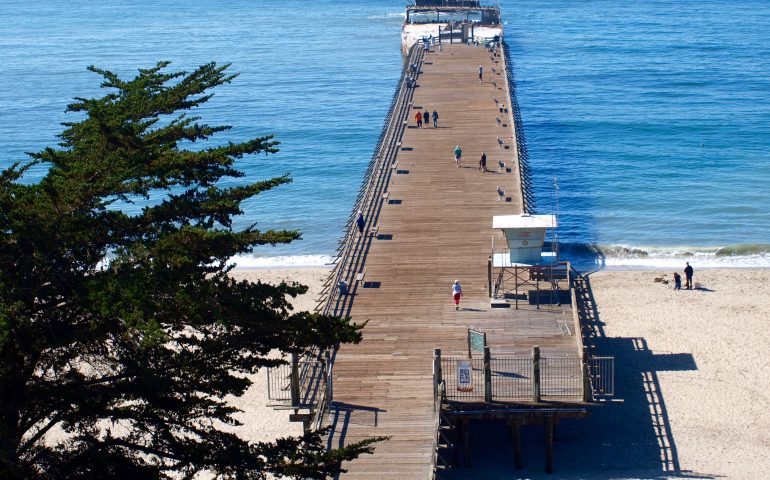
A license ins not required on a public pier.
I absolutely love fishing off the Seacliff State Beach Pier in Aptos – it’s a fantastic spot for anglers in California!
Thank you for the update regarding the closure of the pier due to damage from the winter storms in 2023. It’s unfortunate to hear about the closure, and I understand the uncertainty surrounding when or if it will reopen. It’s essential to prioritize safety and assess the extent of the damage before determining the next steps. If there are any updates or developments regarding the status of the pier, please feel free to share.
When it comes to fire watch guard services in New York, ensuring the safety of buildings and occupants during fire emergencies is paramount. Here’s how to find reliable fire watch guard services:
The Seacliff State Beach Pier Aptos is an amazing place and there are a lot of people searching for these places to plan a visit.
Carnival booths surrounded the back of the ship, a heated swimming pool was installed, a cafe was built above deck, and the main deck was converted into a dance floor.
It certainly looks like it was a great day out when fishing from the Seacliff State Beach Pier. Sorry to hear it has been closed.